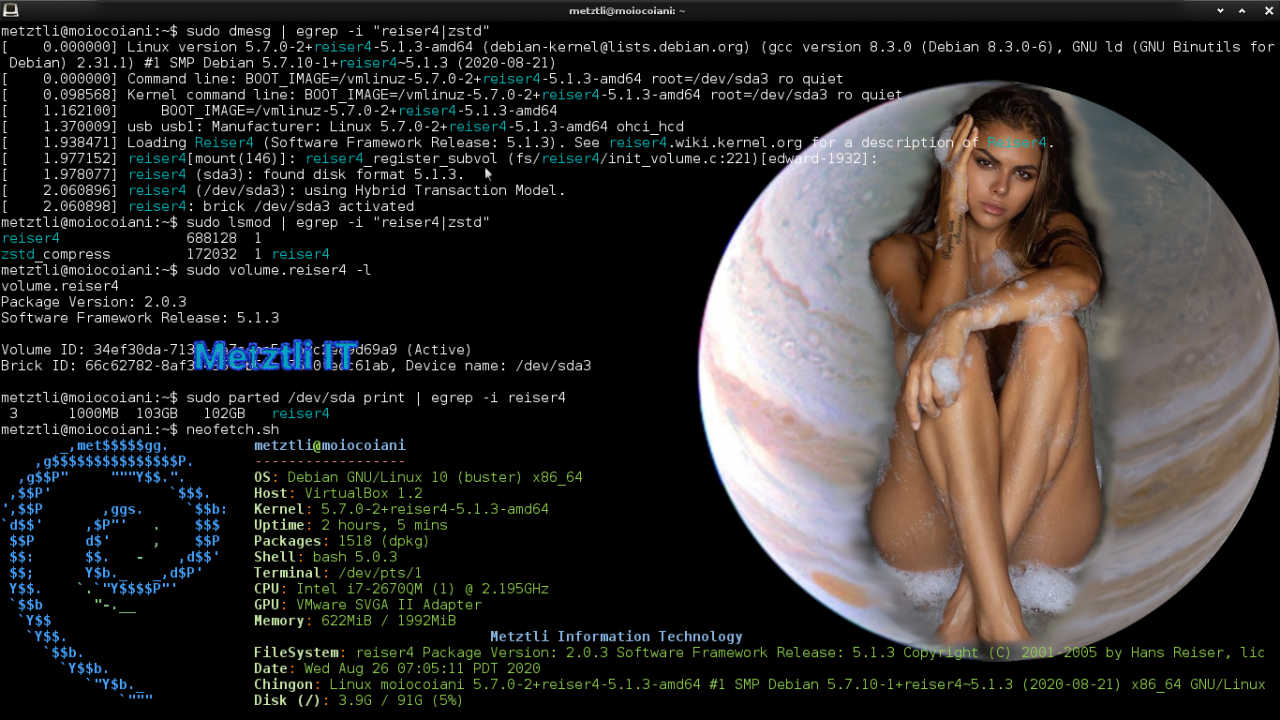
Xochiquetzal in the Temazcalli at Tezcatlipocacitlalli, i.e., 'Jupiter'.
Виктория Одинцова : Victoriya Odintcova embodies Xochiquetzal, the real Mexicah's archetype of feminine beauty.
Unlike European invaders, and more specifically, the Spanish scum invaders who destroyed Mexico - Tenochtitlan, the Mexicah -- after a day of arduous activity -- bathed by relaxing in temazcalli ['sweat lounges,' inanimate objects have no plural in Nahuatl]. It is said that after the fall of Mexico - Tenochtitlan, when European invaders' presence had already initiated mass extinction of indigenous peoples due, allegedly in great part, to the Old World's lack of a basic personal hygiene 'culture' which essentially converted the European aliens into highly contagious bacteria and virus genocidal scumbags (heck, Covid 19 is essentially nothing compared to how contaminated Spain's genetic waste arrived), their European symbiotic plague-carrying rats were already mass multiplying and -- without a natural enemy (cats did not exist here, either) -- their diseases ravaged like fire on the New World.
During the initial phase of those dark times -- which like today are not yet over for the indigenous peoples of this continent (noticed fascist Europe's narcissist 'bastard offspring' USA -backed coup in Bolivia? And the West's sanctions and economic strangulation applied mercilessly on Venezuela, a nation of majority Indigenous and Afro-slave descendants racially mixed except for a minority power-hungry Spanish scum oligarchy begging for 'Murica's military intervention? And the fascist in the White House and his evangelical falunatic thug Secretary of State obliged by promoting another Afro-Obama bogus-change-you-can-believe-in™ unelected puppet as Venezuela's 'president'?) -- the avaricious Spanish scum were not satisfied with their gold and silver allotted booty. With the complicity of their commanding thief plunderer, Hernándo Cortés, his henchmen tortured their high value captives, Cuauhtemoc and Tetlepanquetzal, both last tlahtoaque ['commanders in chief'] of Mexico - Tenochtitlan and Tlacopan altepemeh ['city states'], respectively. Profusely bothered by Tetlepanquetzal's painful whining as the alien Iberian scum burned their feet to force them into confessing the location of an alleged hidden treasure, Cuauhtemoc sarcastically yelled at him, 'Am I perhaps in the delight of a temazcalli!?'
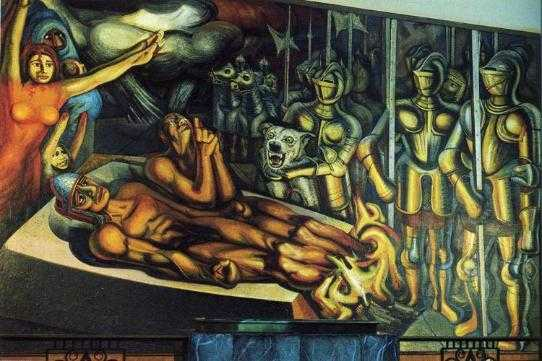
The sarcasm in that phrase was unintelligible to their torturers as the hygienic act of bathing was a one year event, if at all, in the Iberian peninsula -- and much less bathing in an equivalent of a temazcalli. Certainly, there were large semi/enclosed bathing structures left by the Moors in Spain; yet, the fanatic Spaniards used them instead to house their horses. Likely, after consultations with the natives in recalling the sarcasm in Cuauhtemoc's words, the phrase was modified as 'Am I perhaps in a bed of roses!?' probably so that Spain's subsequent genetic waste dumped on this continent could apprehend its meaning.
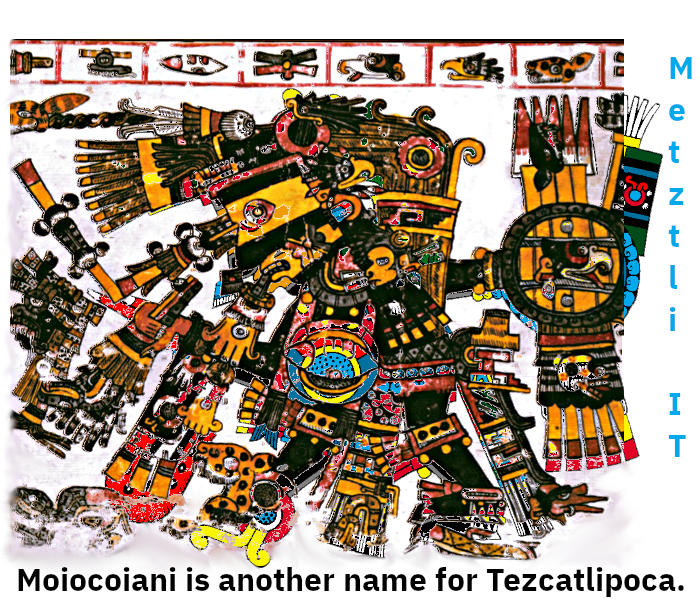
After surviving his ordeal, Cuauhtemoc became known by one of the names by which Moiocoiani, Entity who self-creates, self-thinks, self-invents, or wills, Himself into Being is known: Xonecuiltzin ['El Chueco : The Crippled One']. Such descriptive name invariably conveyed Cuauhtemoc's maimed physical condition. Left permanently unable to recover properly his walking faculty -- after mercilessly being tortured and then violently shoved down a stone stairway by one of his tormentors.
I was dreamin' when I wrote this, forgive if it went astray'
But when I woke up this morning
I could have sworn it was reiser5 day
We Begin Metztli Reiser4 SFRN 5 minimal netboot Debian Buster installation:
Download Metztli Reiser5 from SourceForge site.
On the other hand, if you are paranoid about JavaScript at Source Forge, as a security paranoid acquaintance of mine, attached at the end of this long post please find: metztli-reiser4-sfrn5.iso
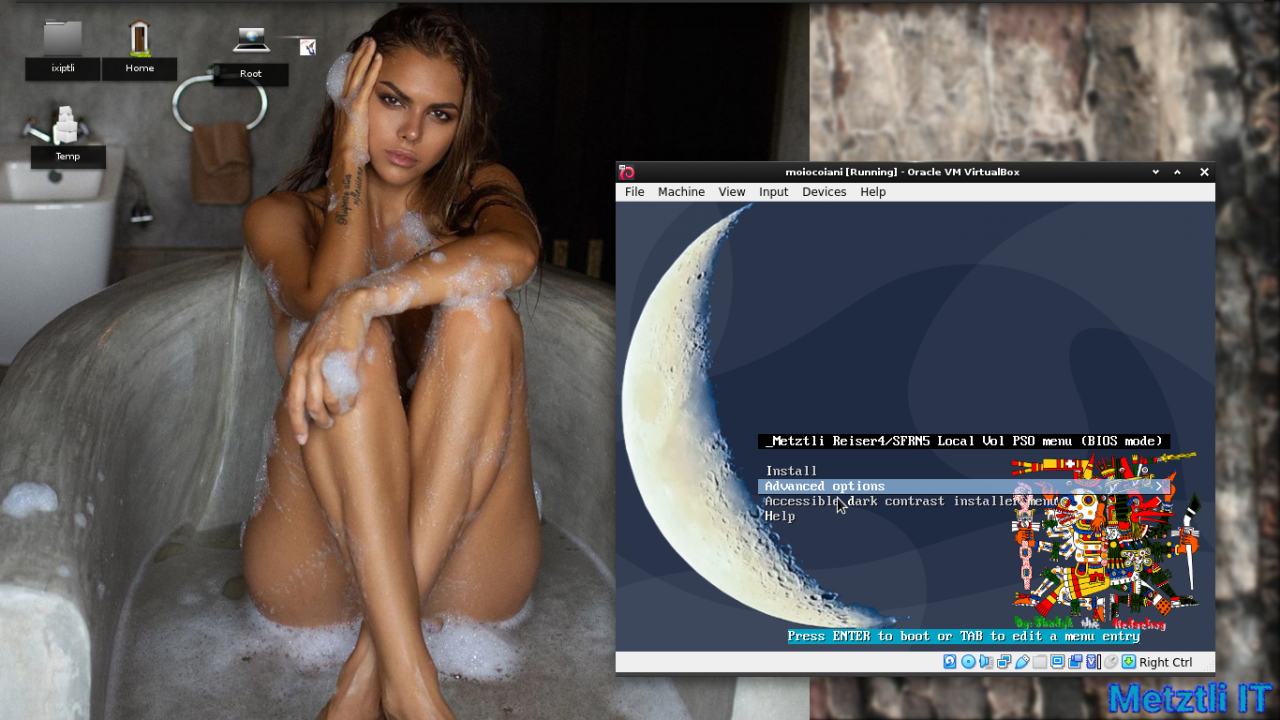
What is referred to as 'Reiser5' filesystem is actually the unstable development iteration of Reiser4, Software Framework Release Number (SFRN) 5.1.3 -- accordingly, 'there is no reiser5, explains reiser4 main maintainer and developer, Mr. Edward Shishkin. Notwithstanding, he contributed to the ensuing confusion by posting his initial message announcing the reiser4 SFRN 5.x.y development iteration as 'Reiser5'.
During my initial attempts to create a Metztli Reiser4 SFRN 5 minimal netboot based on Debian Installer (d-i) for Buster I realized that either the reiser4 sfrn 5.1.3 patch for the Linux kernel and/or the reiser4progs 2.x.y filesystem utilities were not ready. I tried several permutations -- enabled by the Debian Installer components and my own hacks of those -- so as to trigger some feedback that would provide a glimpse into what was causing the installer to detect the target media as if it were a terminal, i.e, refusing to write and unable to execute python -based scripts necessary to upgrade software in Debian.
Subsequently I realized there was only so much I could do on the Debian Installer components domain; thus I began to suspect the issue could be a result of the new reg42 format plugin -- since the pattern of failure(s) was similar as when I formatted the target media in an unsupported format, like that of zstd1 format plugin. Heck, I even stripped the Zstd code from the reiser4 SFRN 5 filesystem before building a given kernel but nothing essentially changed.
Nevertheless, a couple of days ago, as I had finished updating Metztli Reiser4 for Intel and AMD Ryzen / Epyc, Moiocoiani asked, what if... And subsequently I began the procedure of building a fresh Metztli Reiser4 SFRN 5 Zstd -compressed Linux kernel 5.7.10 and initramfs-tools, reiser4progs 2.0.3, and rewrote some sections of d-i, accordingly.
I, but not Moiocoiani, was in disbelief -- this time everything worked smoothly!
Below, various snapshots tersely commented reveal a Metztli Reiser4 SFRN 5 netboot installation where Debian is natively installed onto a reiser4 SFRN 5.1.3 -formatted target ~ 100 GB media created in VirtualBox 6.1.12 hypervisor 2. This showcases that Metztli Reiser4 SFRN 5 is the first Debian metaframework -based distribution enabled to create, modify, repair, backup, format, and natively install onto, the NEW reiser4 sfrn 5.x.y, also known as reiser5, currently in development. Chingon! ![]()
Although not strictly necessary, we select expert install as the routine will enable more options, like including additional languages besides the local detected one.

Select language. hmmm... there is no Nahuatl, so I select English default detected.
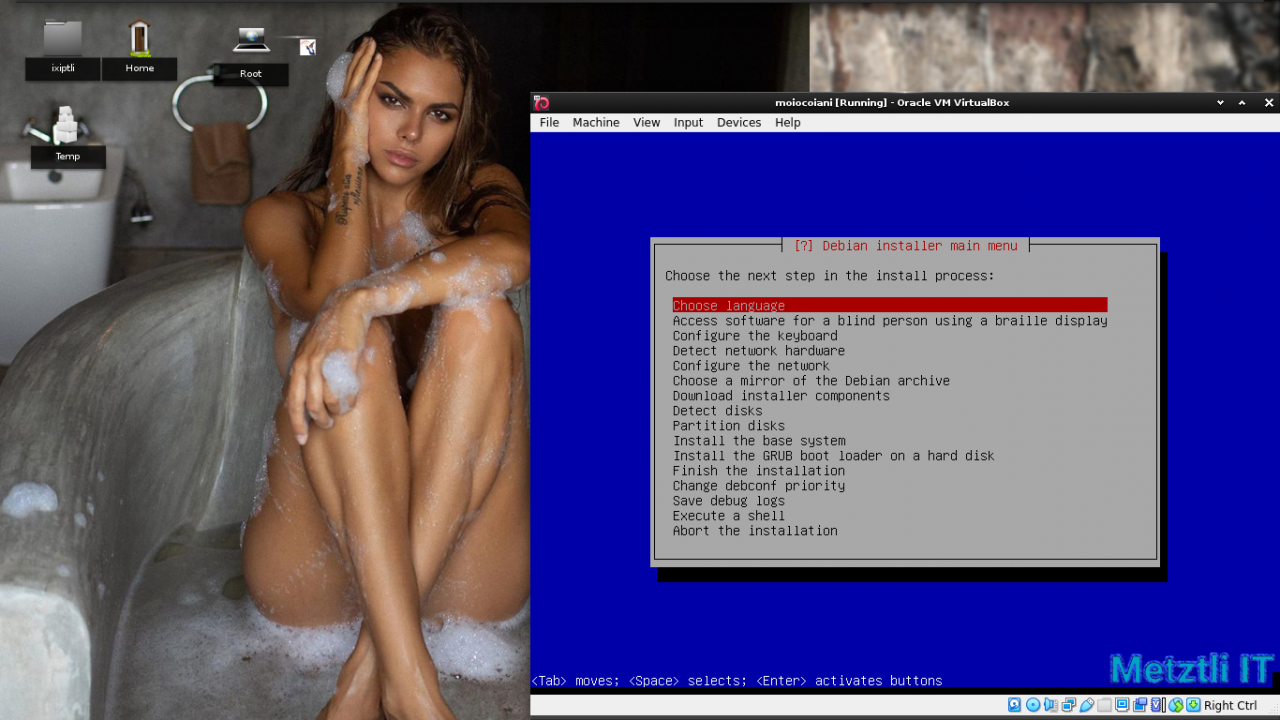
We may also add Вики Xochiquetzal's native language, Русский : Russian.
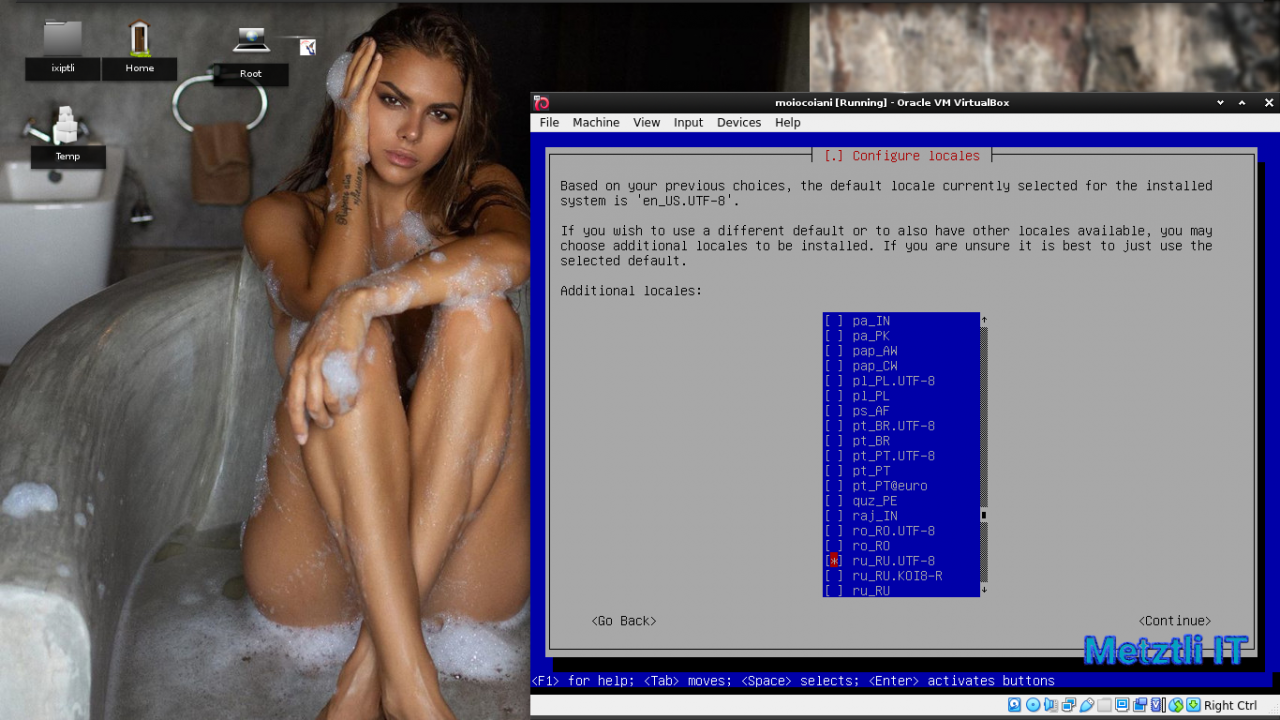
Next, we Configure our keyboard

Detect network hardware, card, etc.
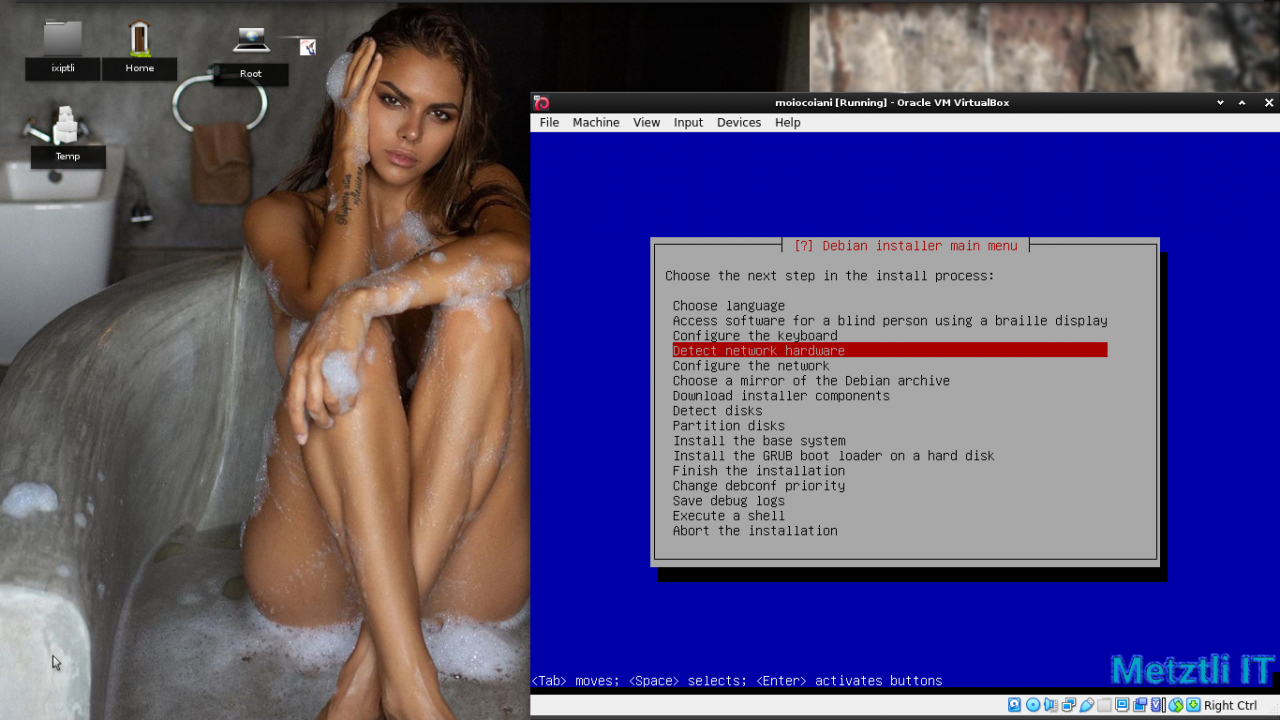
You may want to use your keyboard space bar to select/deselect modules to load, like USB unit containing network device drivers, etc..
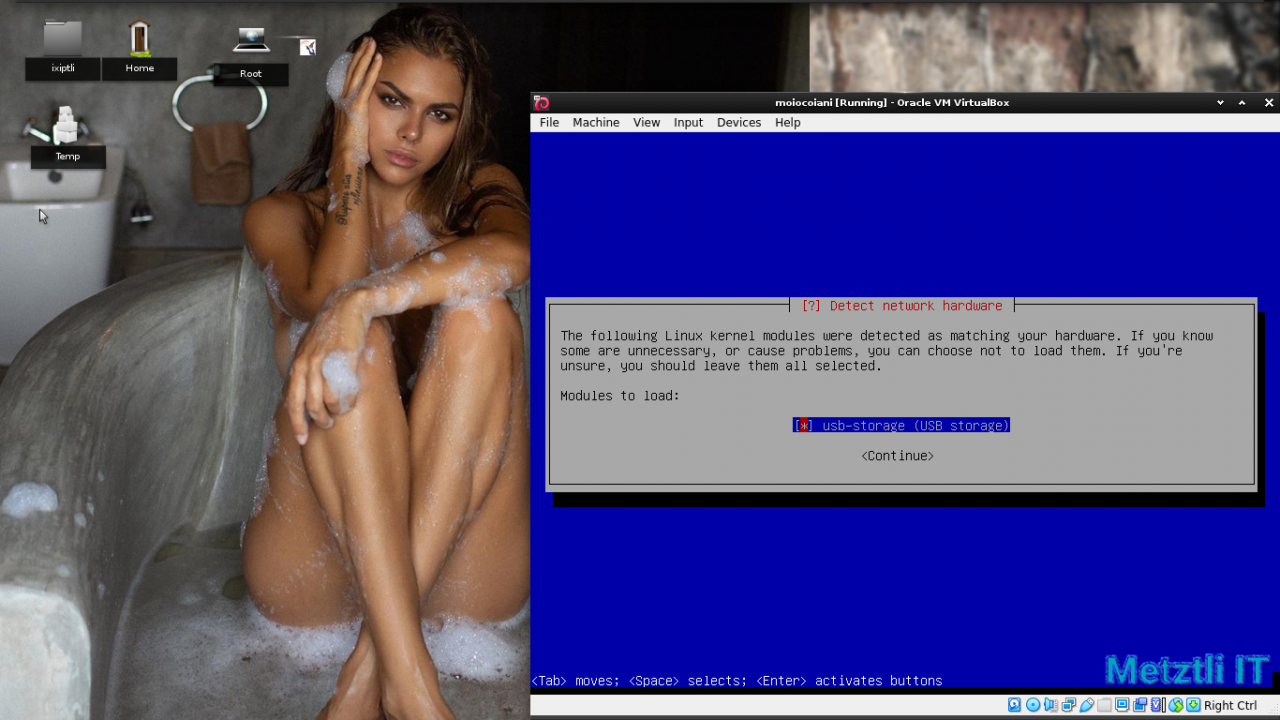
Configure the network
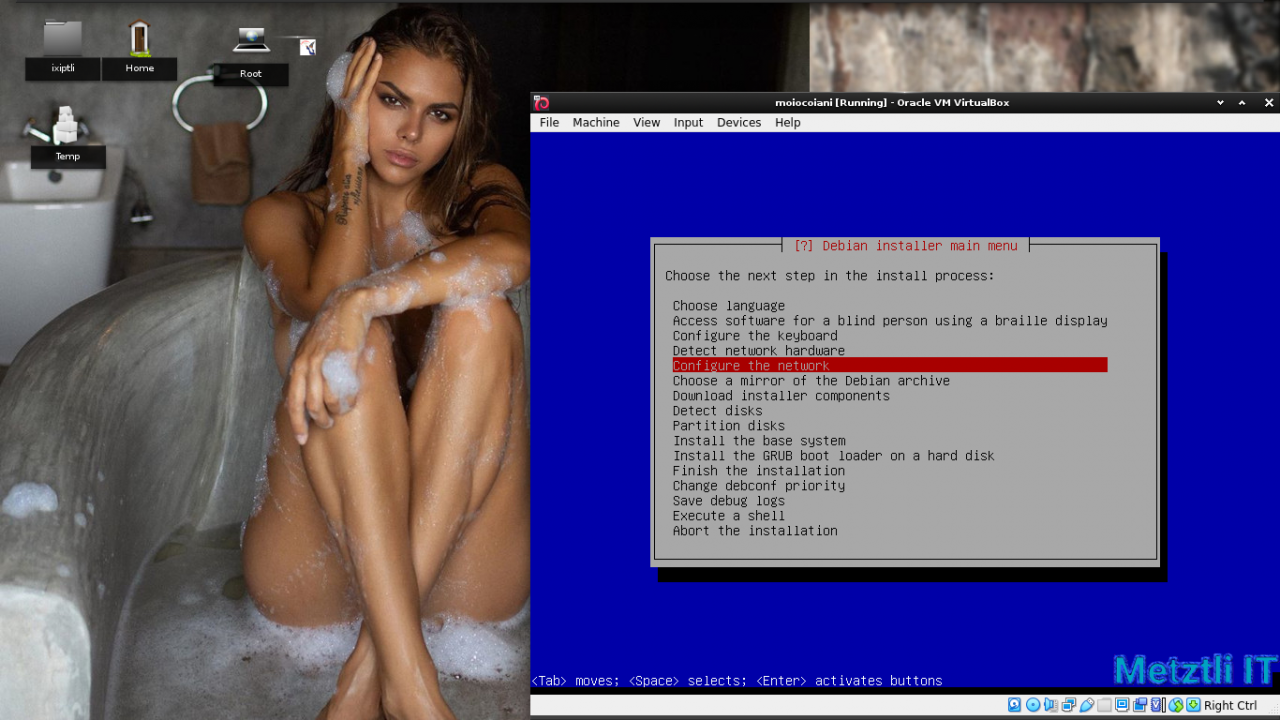
We have the option either to allow automatic network configuration with detected settings and/or manually via settings acquired from a virtual or physical hosting provider suitable for our remote server.
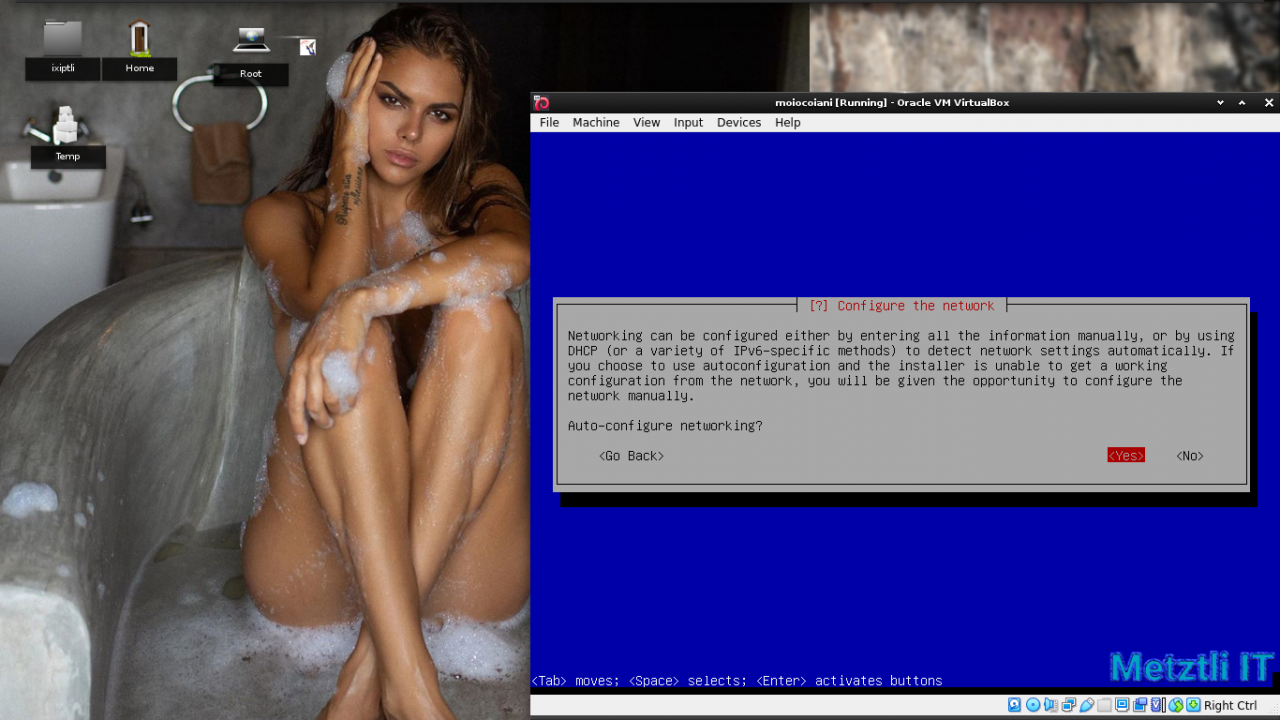
The Hostname for your Metztli Reiser4 SFRN 5 system. Setting will be reflected in the /etc/hosts file.
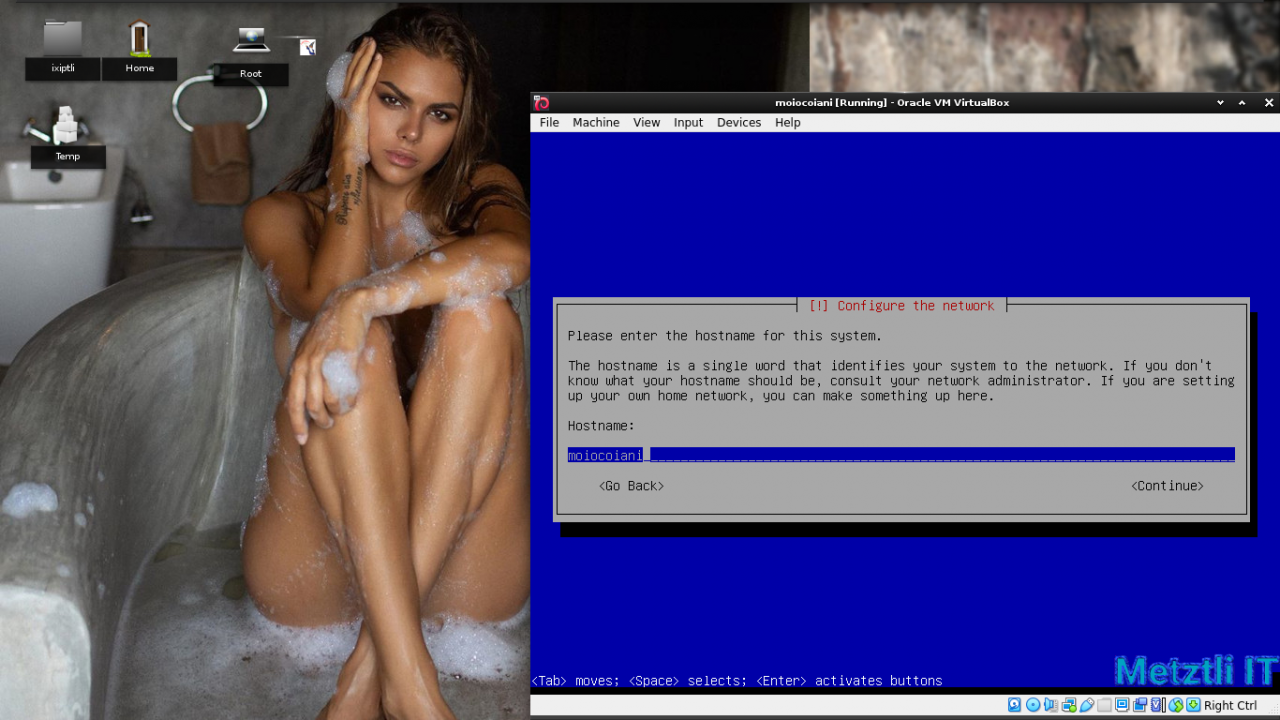
Complete your domain name. Setting will be reflected in the /etc/hosts file.
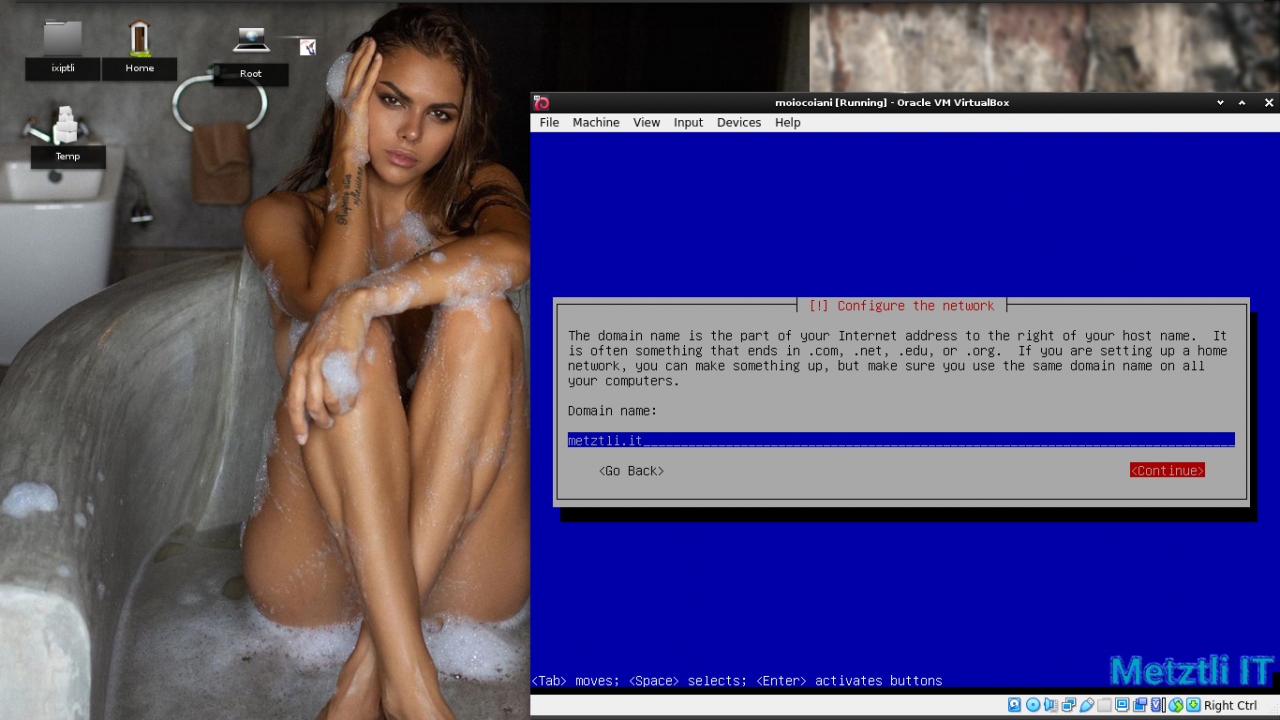
Select your country's, or arguably nearest region, mirror of the Debian repositories archive.
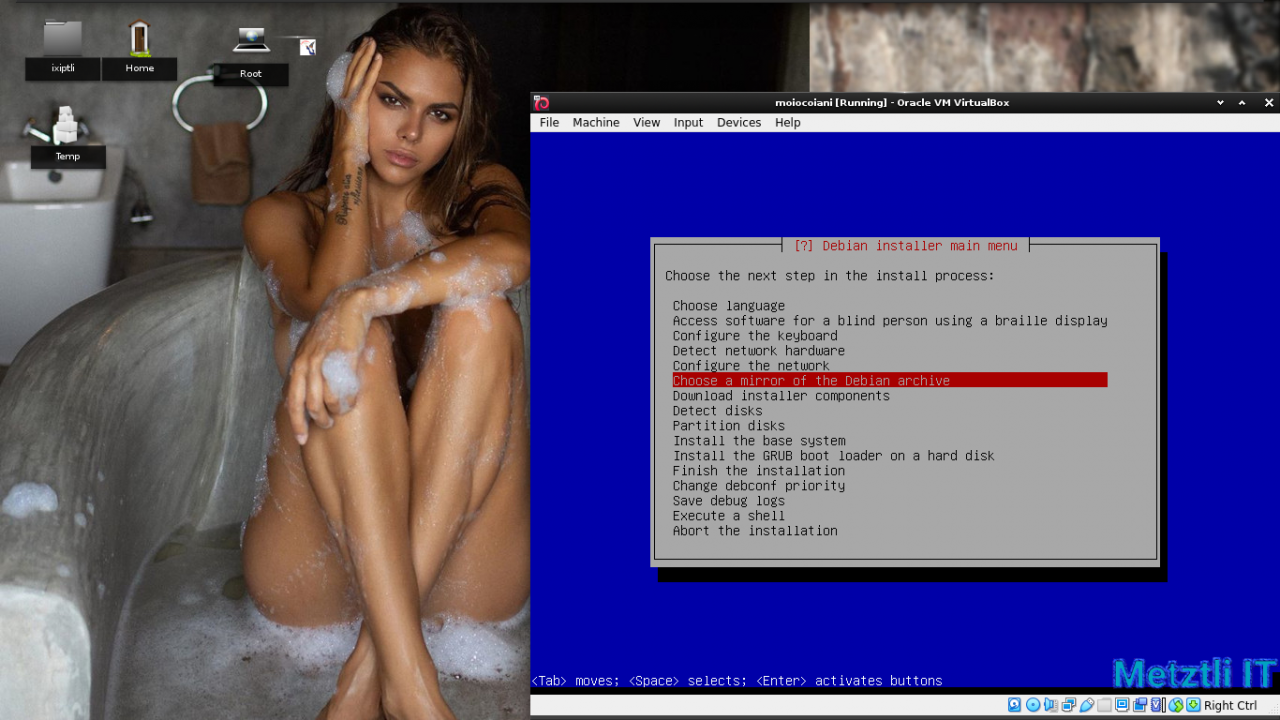
I have not tested installation with Bullseye (testing) nor Sid (Unstable). Although some components in Metztli Reiser4 SFRN 5 netboot were built from Debian Buster backports, the stable Buster version is what I generally install both, locally and in remote cloud and/or physical instances.
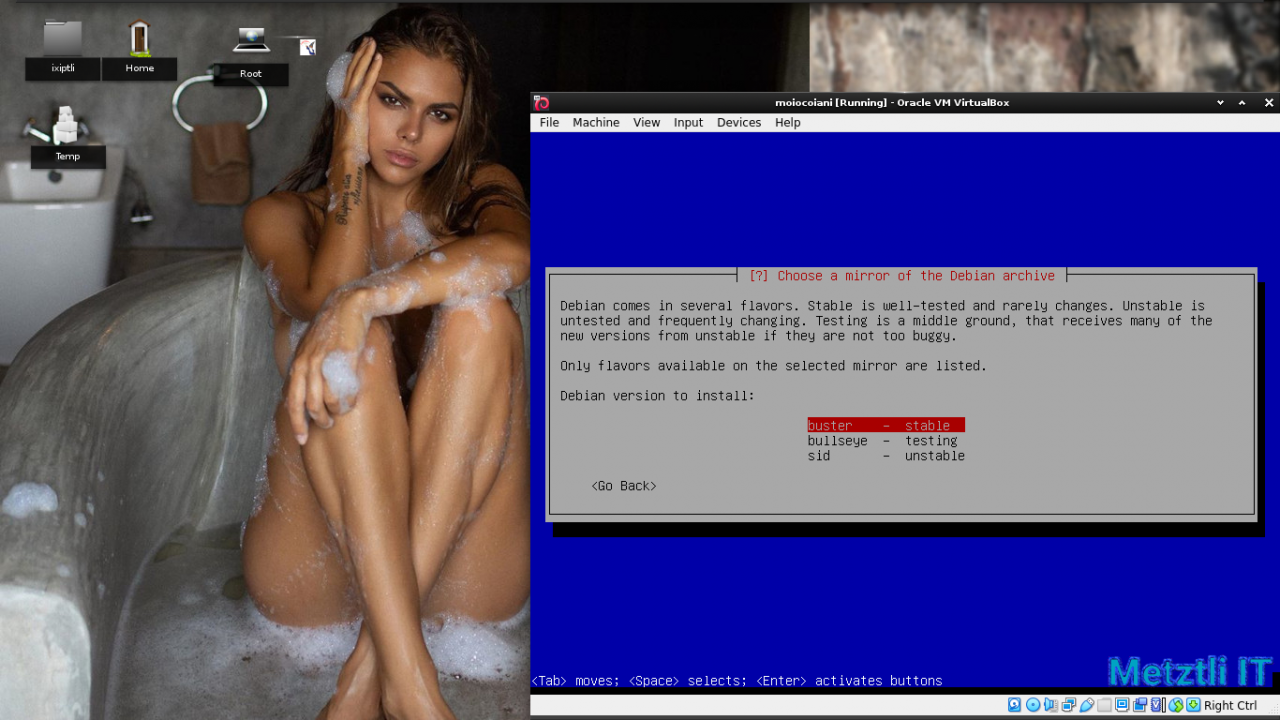
Ensuing installer dialog: Download installer components. Yes, this installer has most non-free firmware, as well, so as to facilitate installation, i.e., IP over KVM, iLo, etc., where we likely do not have access to USB devices for additional software/hardware drivers.
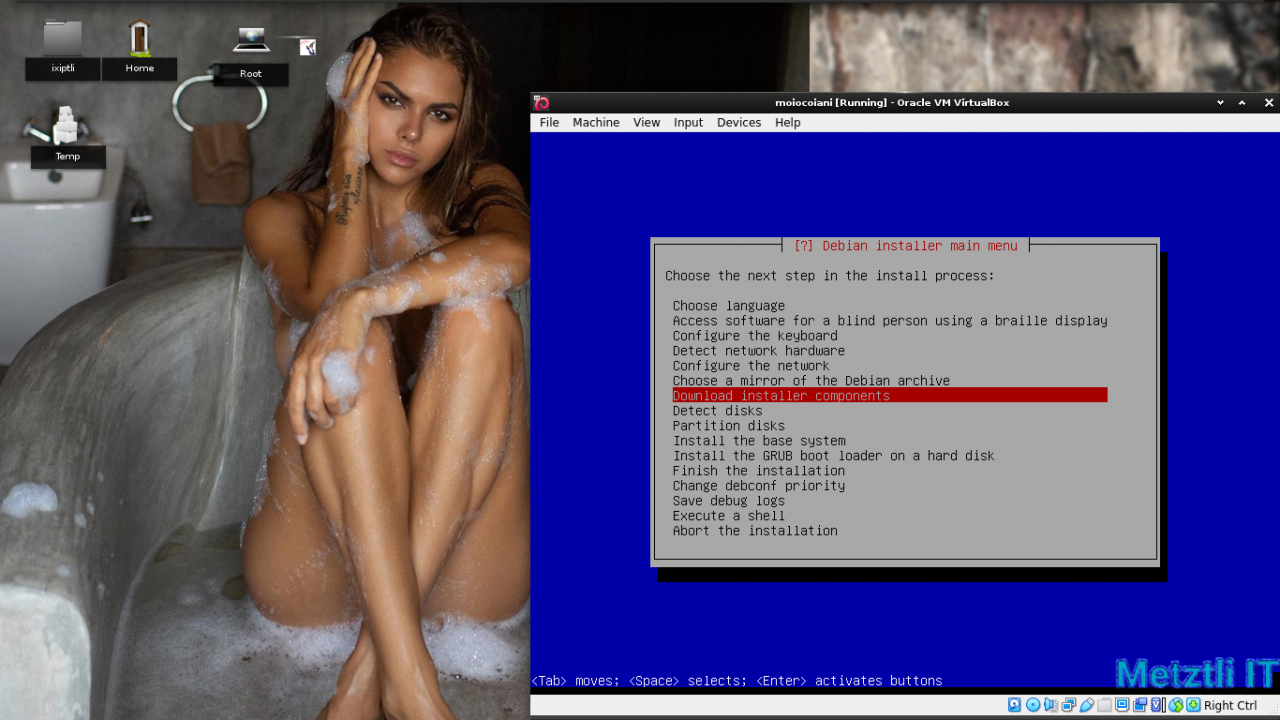
Of course, No kernel modules were found. Metztli Reiser4 SFRN 5 netboot supplies the custom reiser4 sfrn 5.1.3 modules, so I select Yes to the prompt asking, Continue the install without loading kernel modules?.
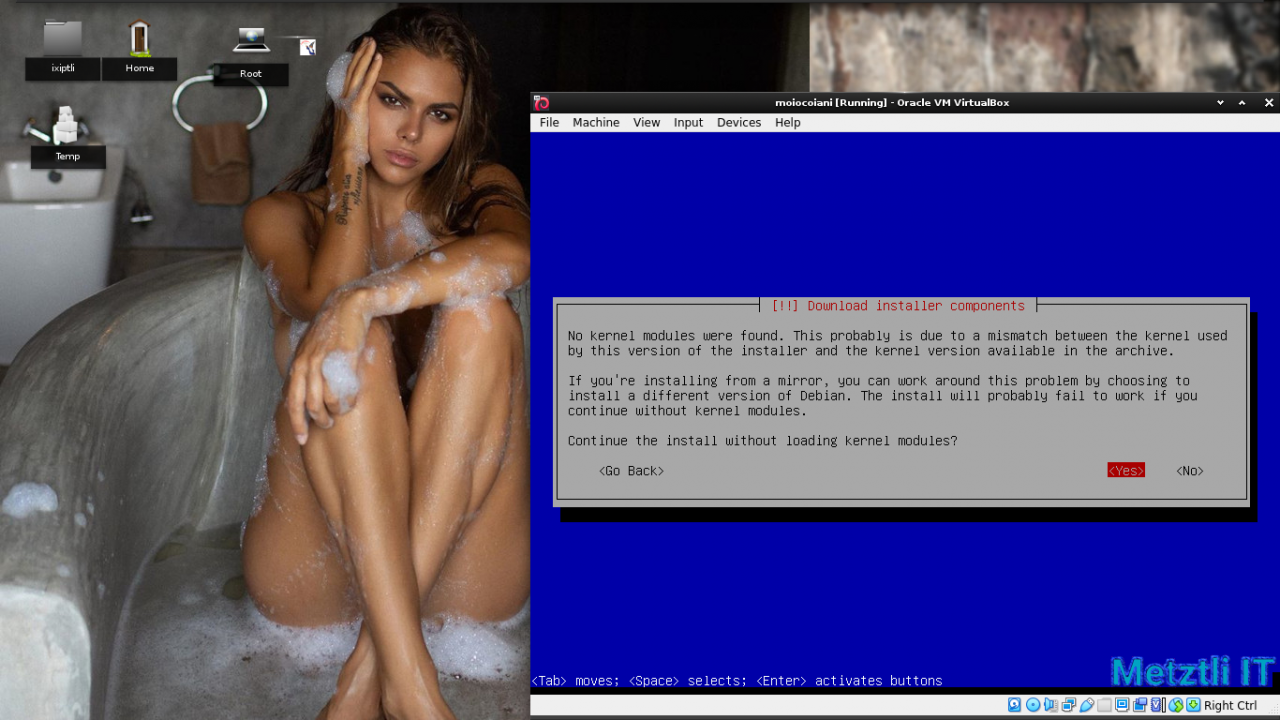
For an illustration of how a Debian metaframework -derived Metztli Reiser4 SFRN 5 installation may be continued from another machine in your network, I have decided to select component network-console: Continue installation remotely using SSH, in addition to openssh-client-udeb: secure shell client for the Debian installer; the latter is the only one usually selected during remote installations, i.e., IP over KVM, iLo, etc.., but not the former -- probably unless we also have at least another server in that network from where to continue the installation.

I start up another virtual machine, in the VirtualBox 6.1.12 virtual network, with a GNOME3 -based Debian Desktop GUI. Meanwhile,

If another machine in our network will be picking up over our partial Metztli Reiser4 SFRN 5 installation, we must provide a strong password for the user at the alternative remote machine to securely connect to our installer instance.

The strong password will be necessary, as well as the IPv4 or IPv6 address of the machine where the installation is being performed, for the remote installation to proceed.
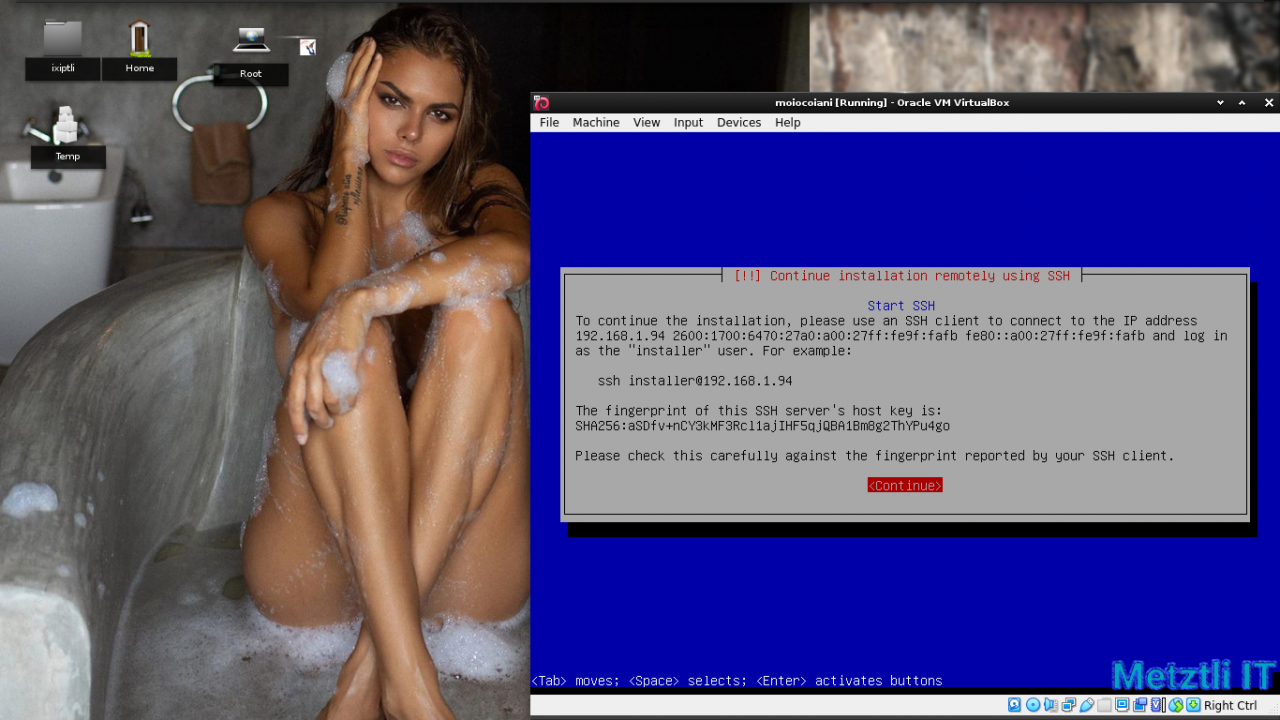
Using the information provided by the installer, from our 'remote' machine, ВикиXochiquetzal, we connect to the IP provided and as the user installer, confirm our intention to connect, and type the strong password previously created and already registered by the installer.
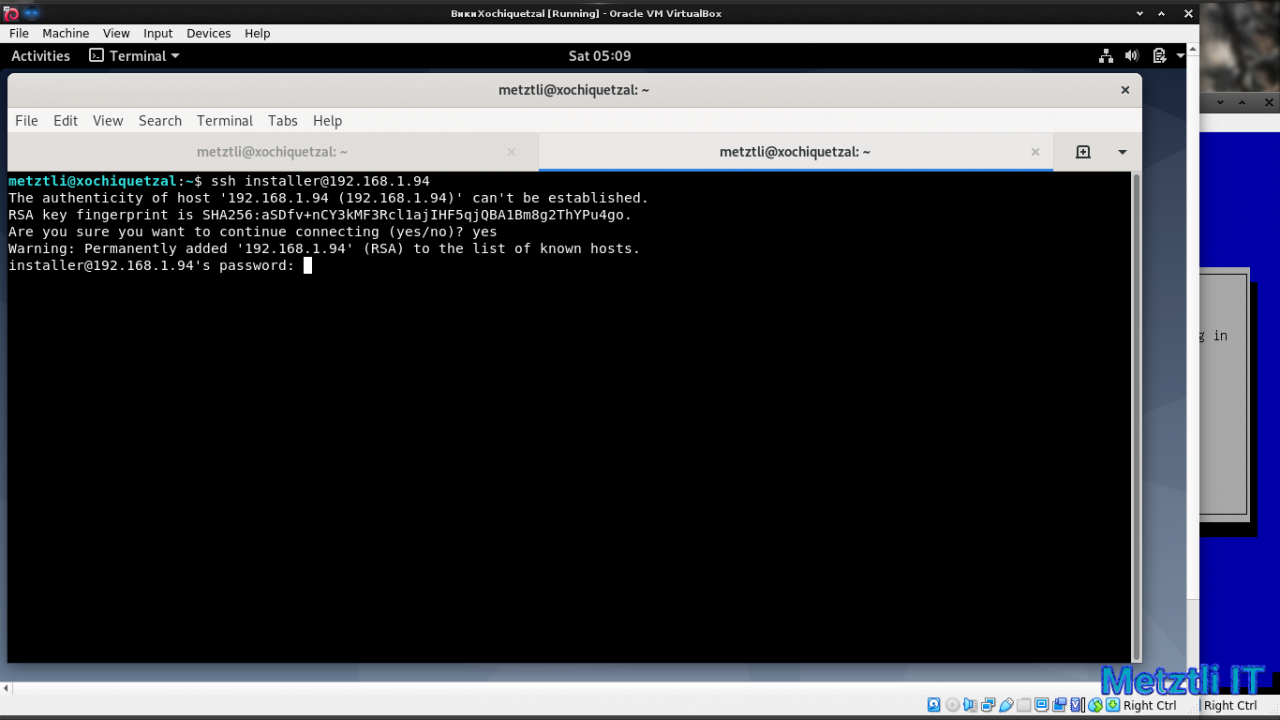
Once 'remotely' connected to the machine where the installation is taking place, we pick up the point in the installation routine where the previous installer instance left off. Again, we select expert mode.
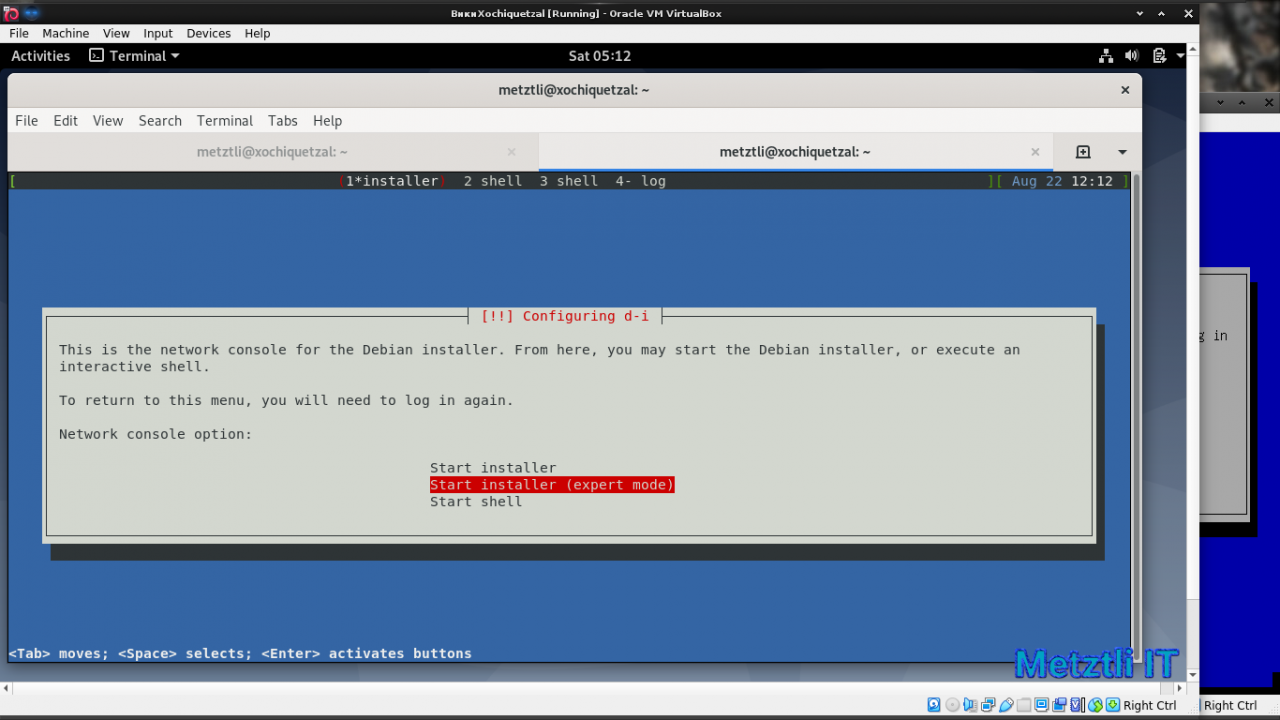
We need to specify who will be using our Metztli Reiser4 SFRN 5 system.
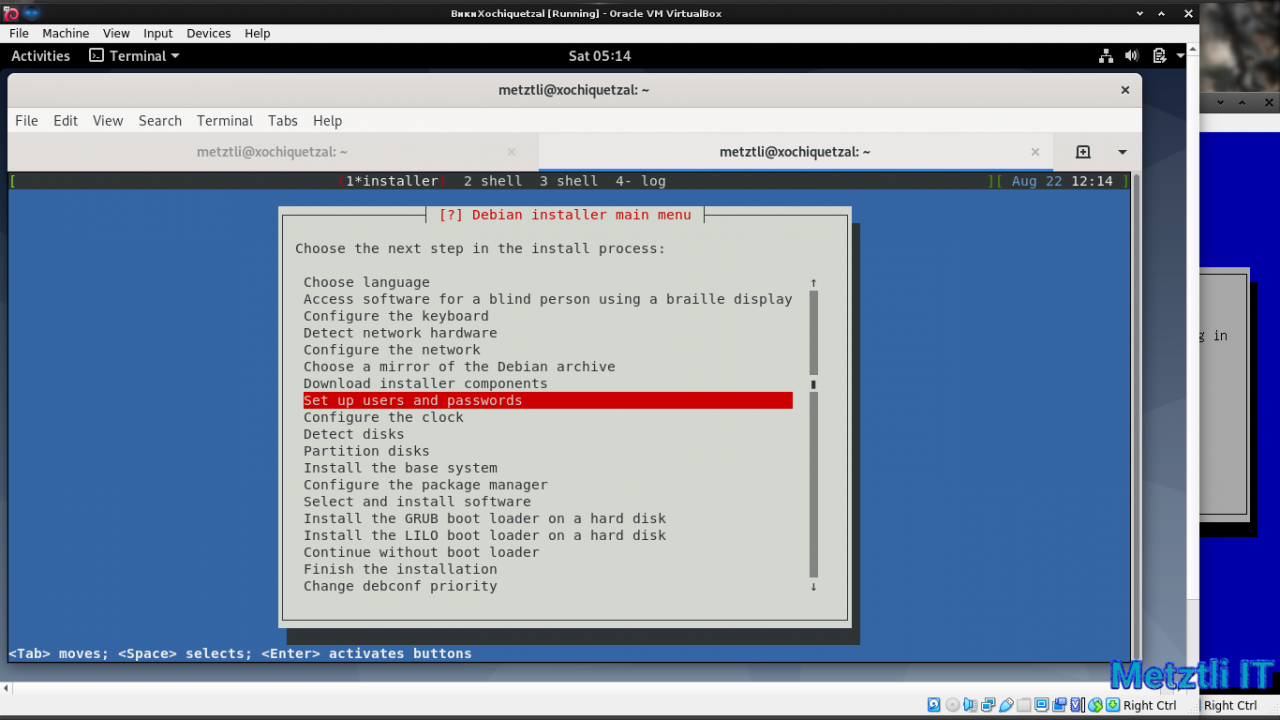
The use of shadow passwords is strongly recommended by Debian unless your environment is NIS and other especial cases.
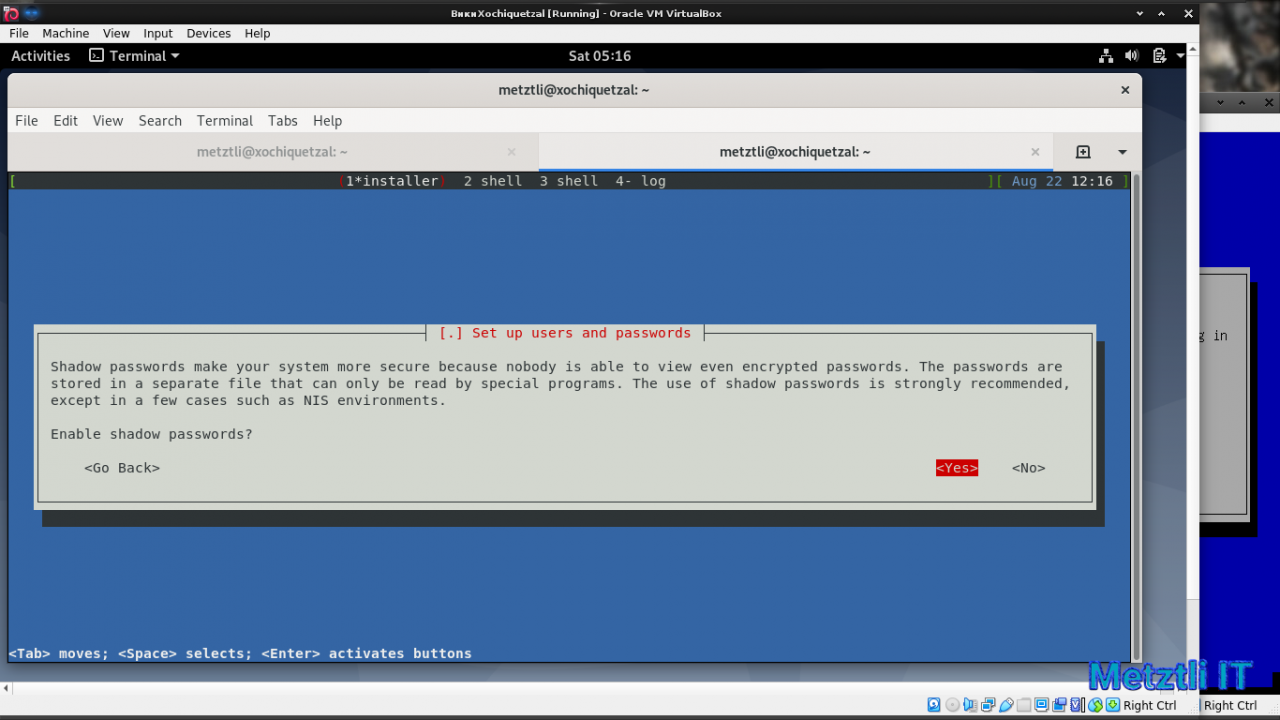
If you are installing any system on a remote provider's infrastructure open to the wild Internet, you must be careful allowing root account login, as almost immediately upon you finish your system installation -- upon rebooting and perusing the /var/log/auth.log -- you will be surprised at the often copious quantity of remote IPs attempting to log into your system by brute force user name/password guessing; root user is the proverbial low hanging fruit for them to try and if your password is weak you will be effectively compromised right away. Accordingly think of the next option, which defaults to Yes, carefully.
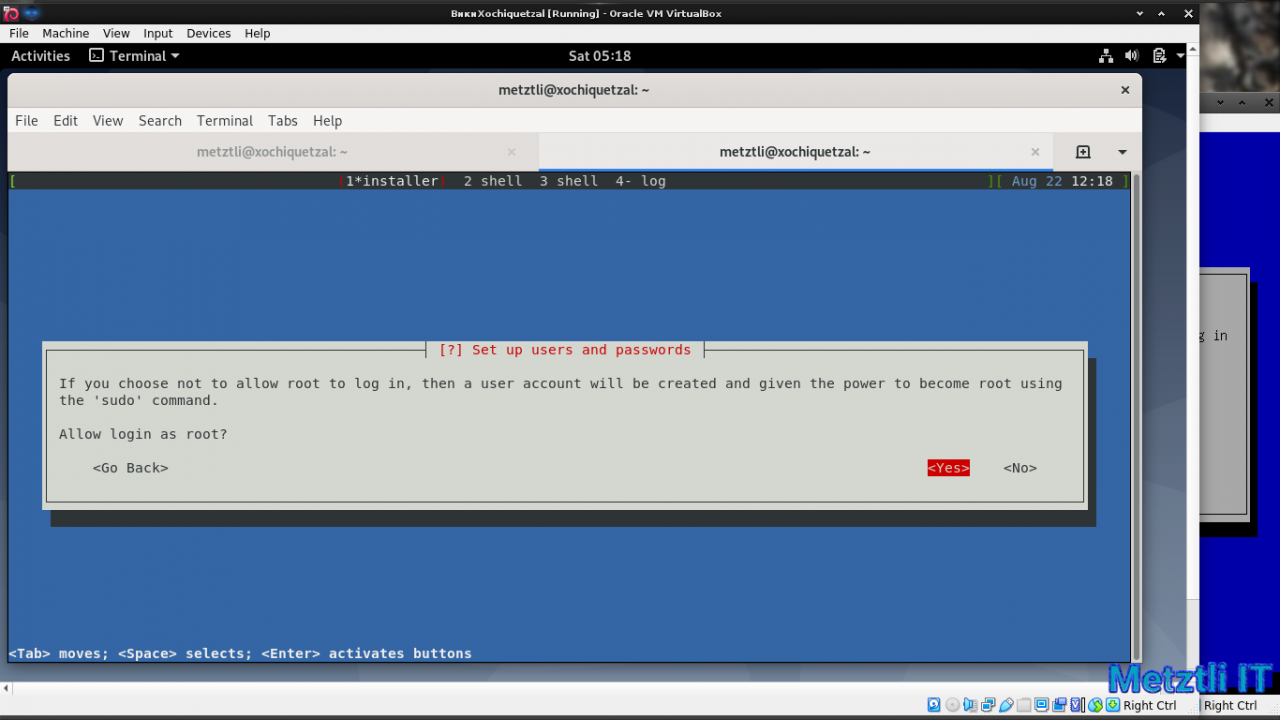
Regardless of prior decision, a non-root user, i.e., regular, account is created for non-administrative tasks.
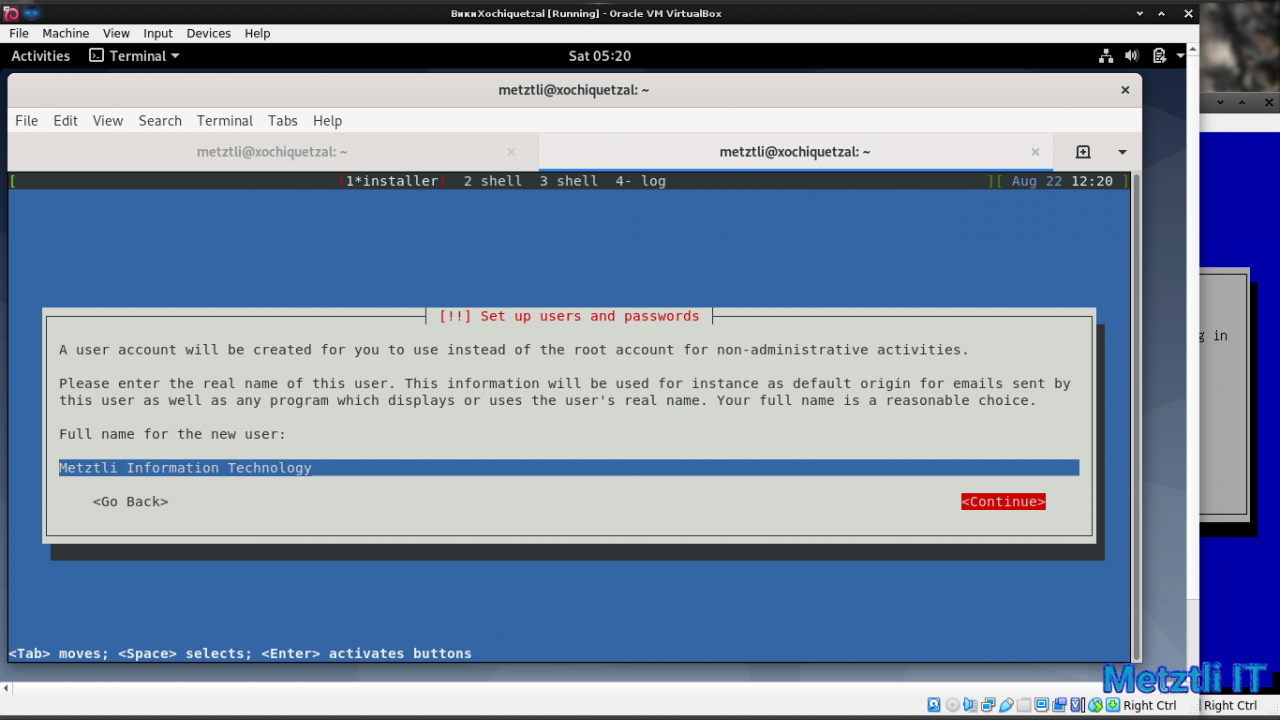
If you user name is two or more character strings, the first of those will usually be suggested for your account.
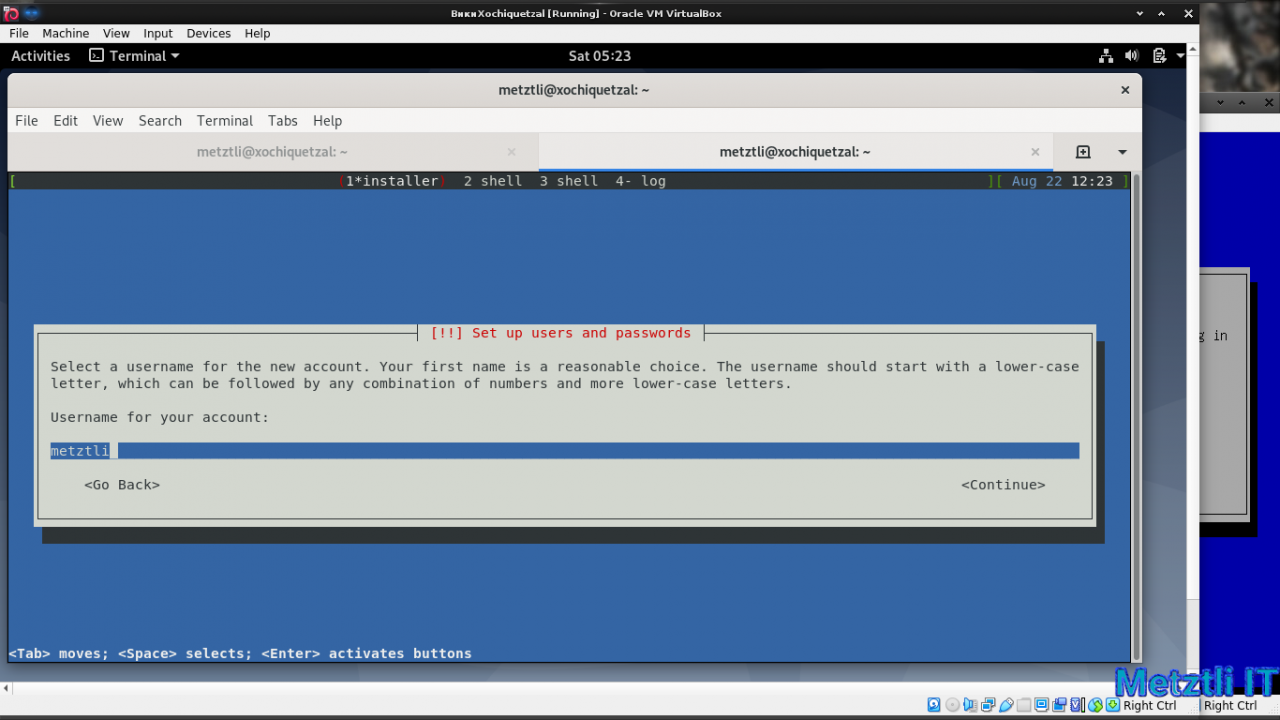
I will be decreasing the GUI window size of the 'remote' virtual machine where the installer is running as I press the equivalent of CTRL+ALT+F4 to provide a peek into what is happening at the virtual machine where the installation is taking place.
Time to set the clock:
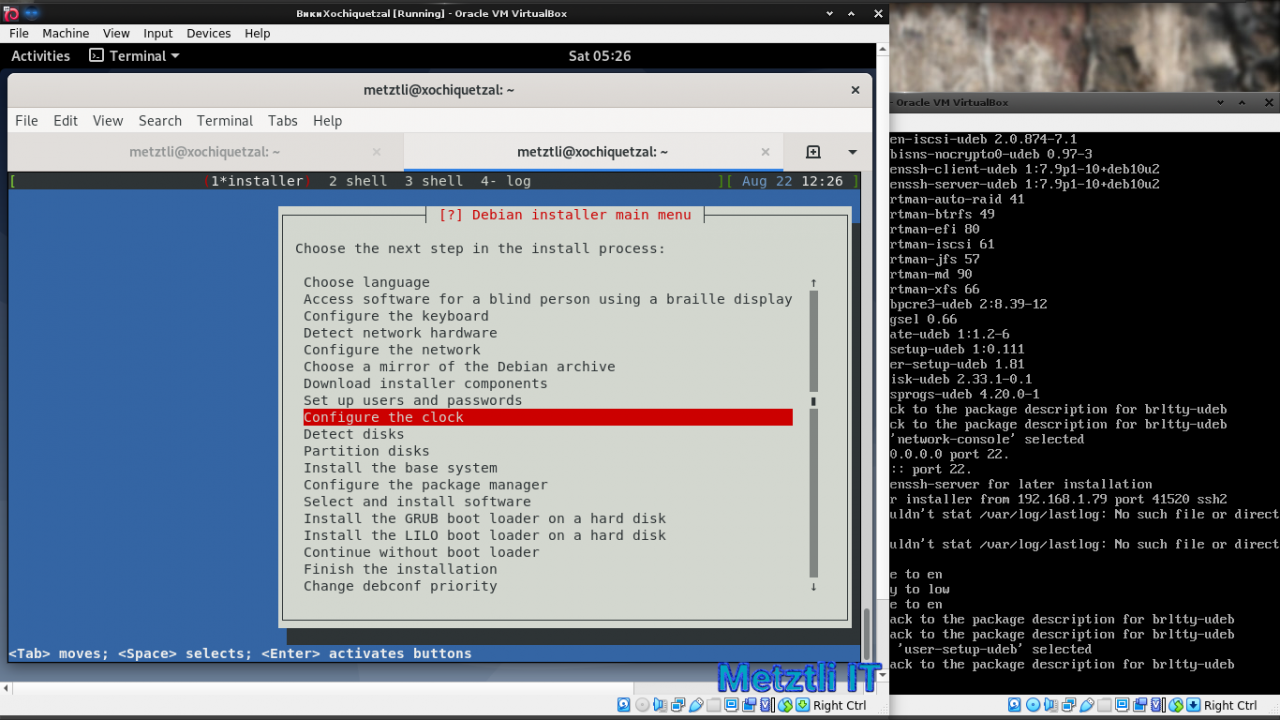
...and the time zone:

The installer menu reappears with Detect disks entry highlighted, press Enter key:
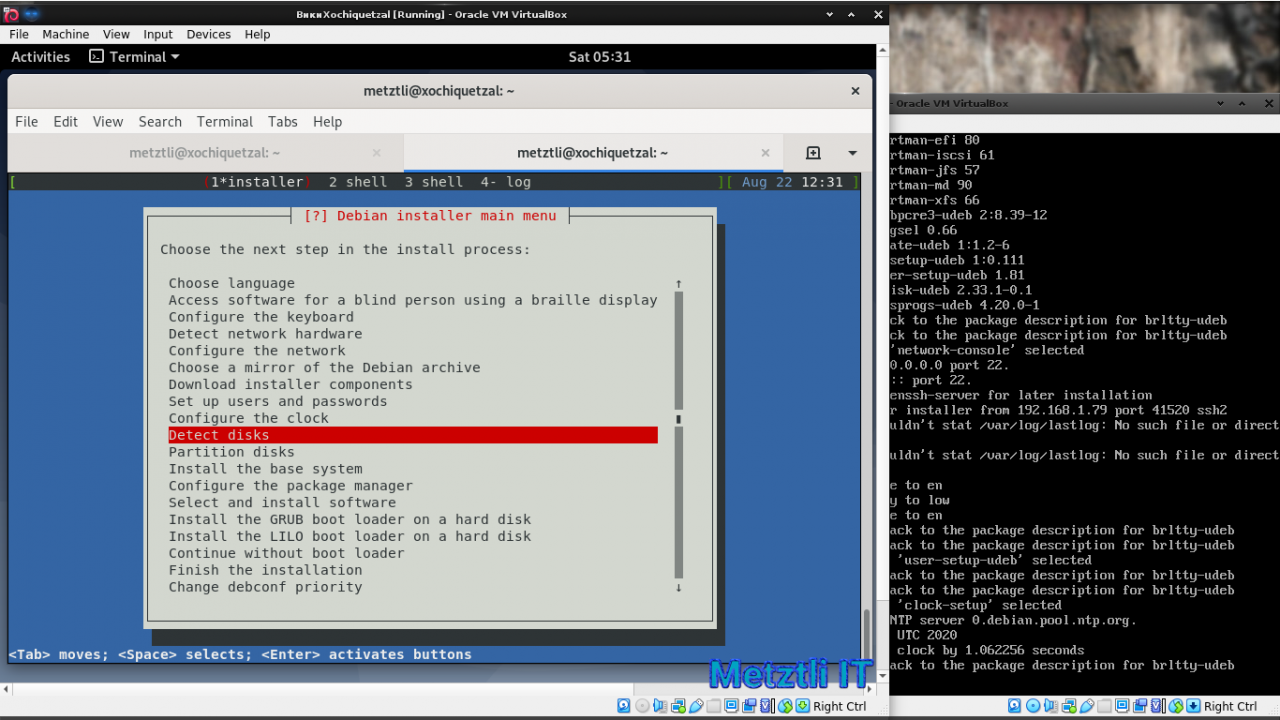
After the detection routine finishes, the installer returns with Partition disks highlighted, again press Enter key:

The ensuing dialog offers a couple of partitioning methods: Guided - use entire disk. or Manual; I select the latter.
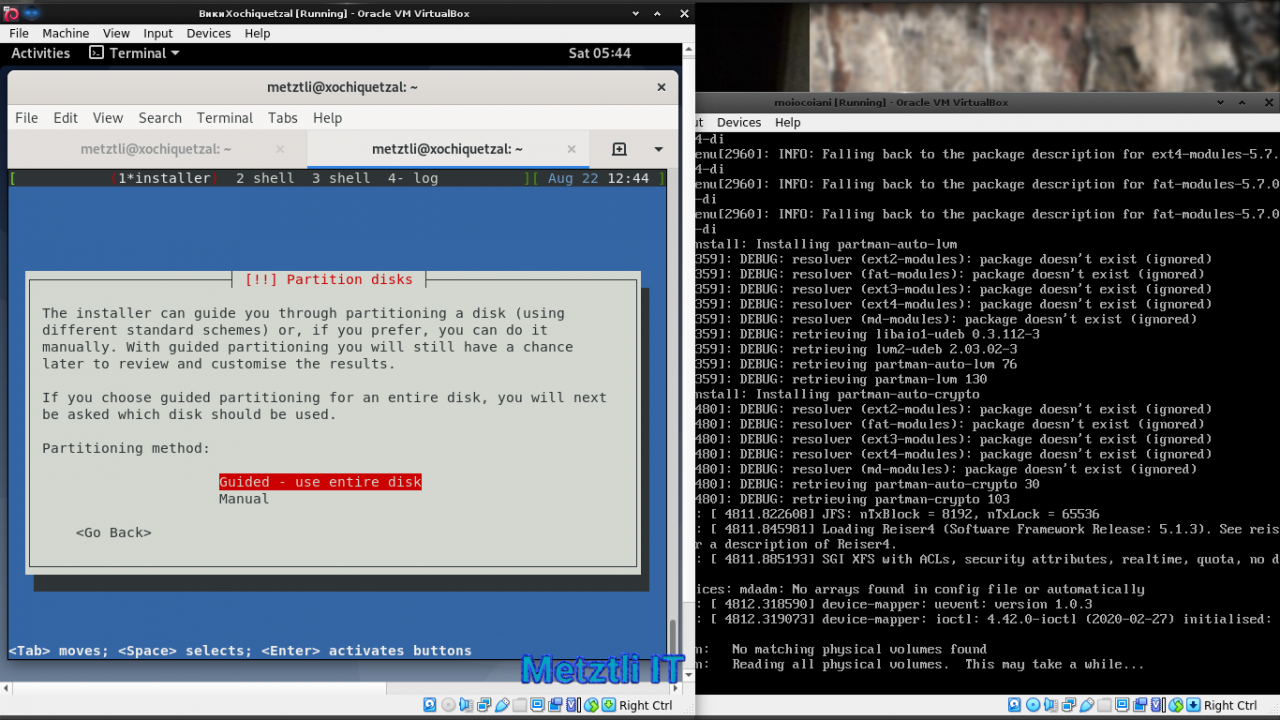
As the installation will be taking place on a Virtual Box 6.1.12 newly created raw virtual storage device, I will be initializing its partition table:
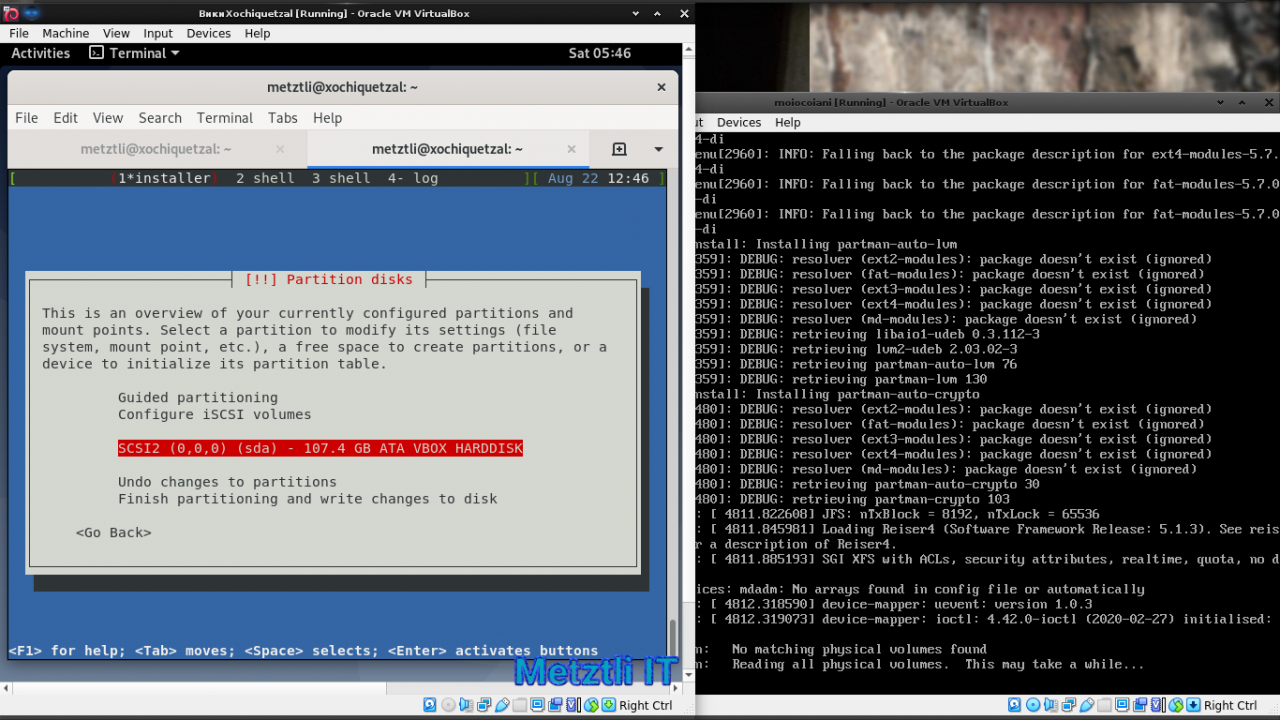
You may notice on the installation machine screen output that the Reiser4, Software Framework Release Number 5.1.3, module has been loaded automagically. It is only during rescue operations when a dialog prompts to specify which device should be used as root that the user, pressing CTRL+ALT+F3 --for instance -- to open a tty, proceeds to type
Shell
modprobe reiser4 |
Of course, I am assuming that the device to be used as root is also formated in reiser4.
Creating a new empty partition table on the highlighted raw SCSI device:
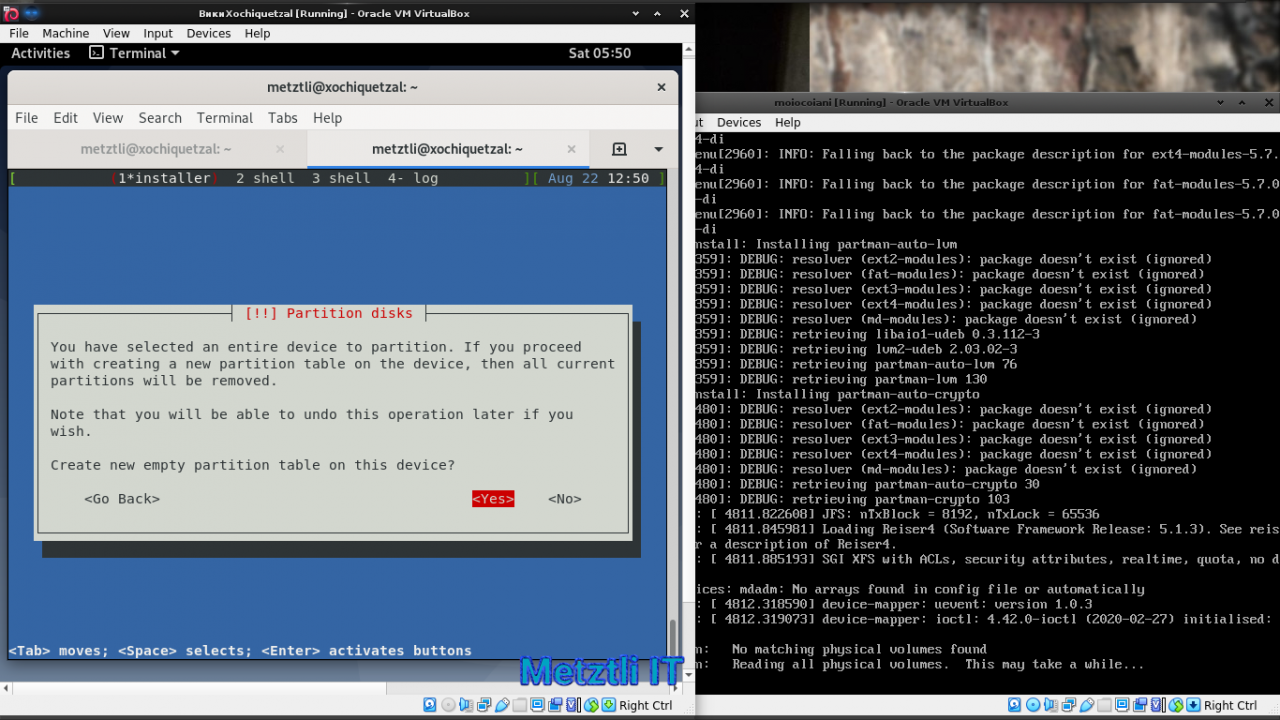
I select GUID Partitioning Table (GPT) scheme as the type. Please note that guided installation defaults to msdos type which severely constrains partition operations.
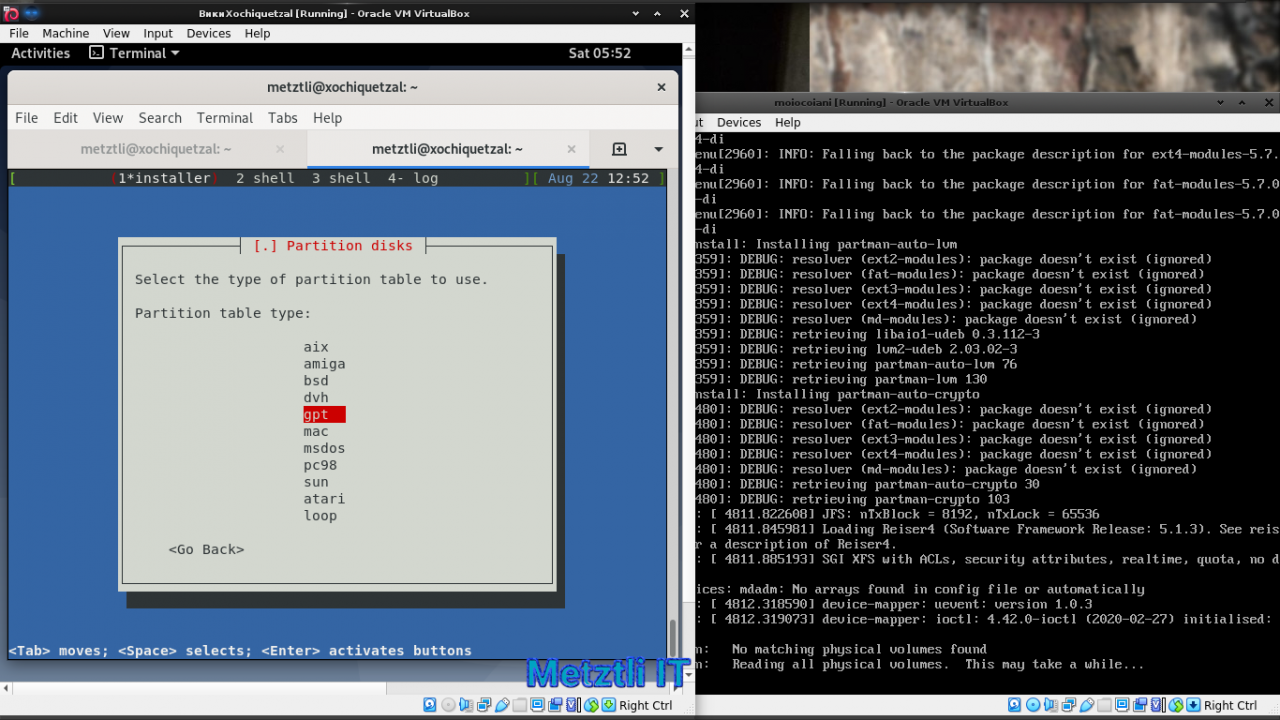
After the raw disk device is initiated with a GPT empty partition table, then I select the free space of an approximately 100 GB disk for a suitable operating system partitioning scheme.

I start by creating a new partition, one of three that I will be creating, except for the format of those partitions, the creation procedure is similar.
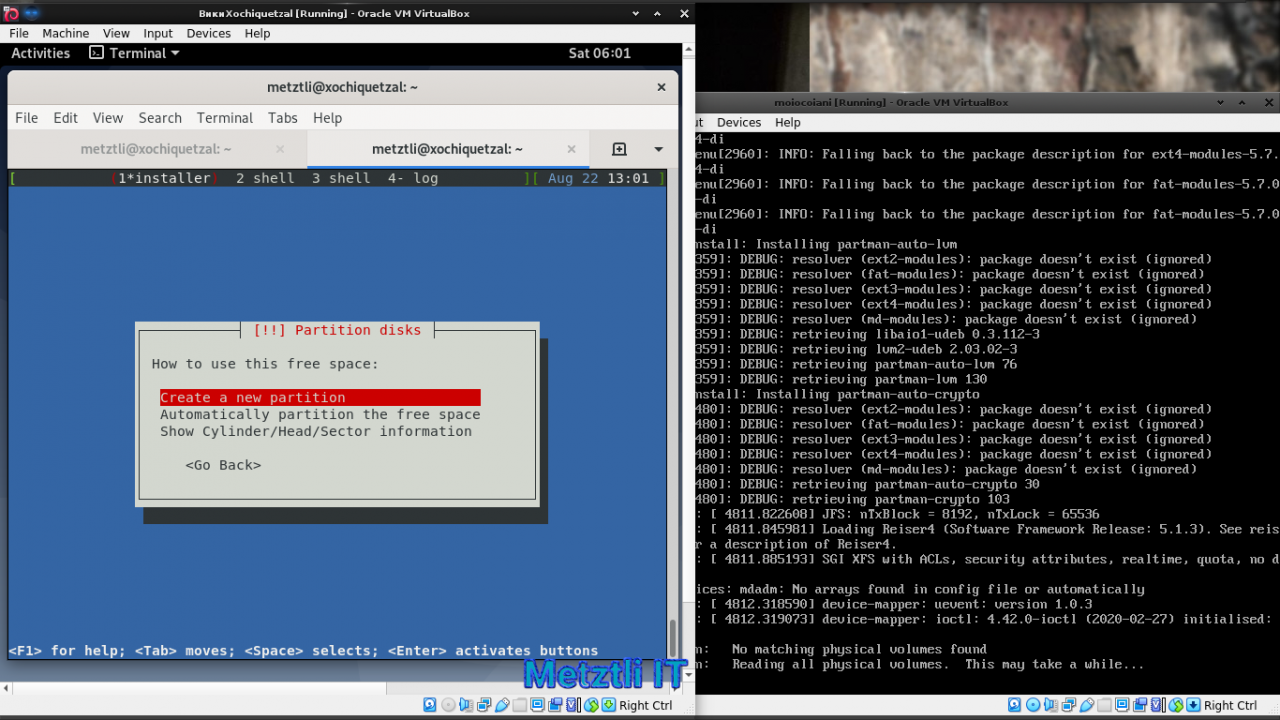
I modify the size setting from a partition occupying the whole disk storage device to one(1) GB partition:
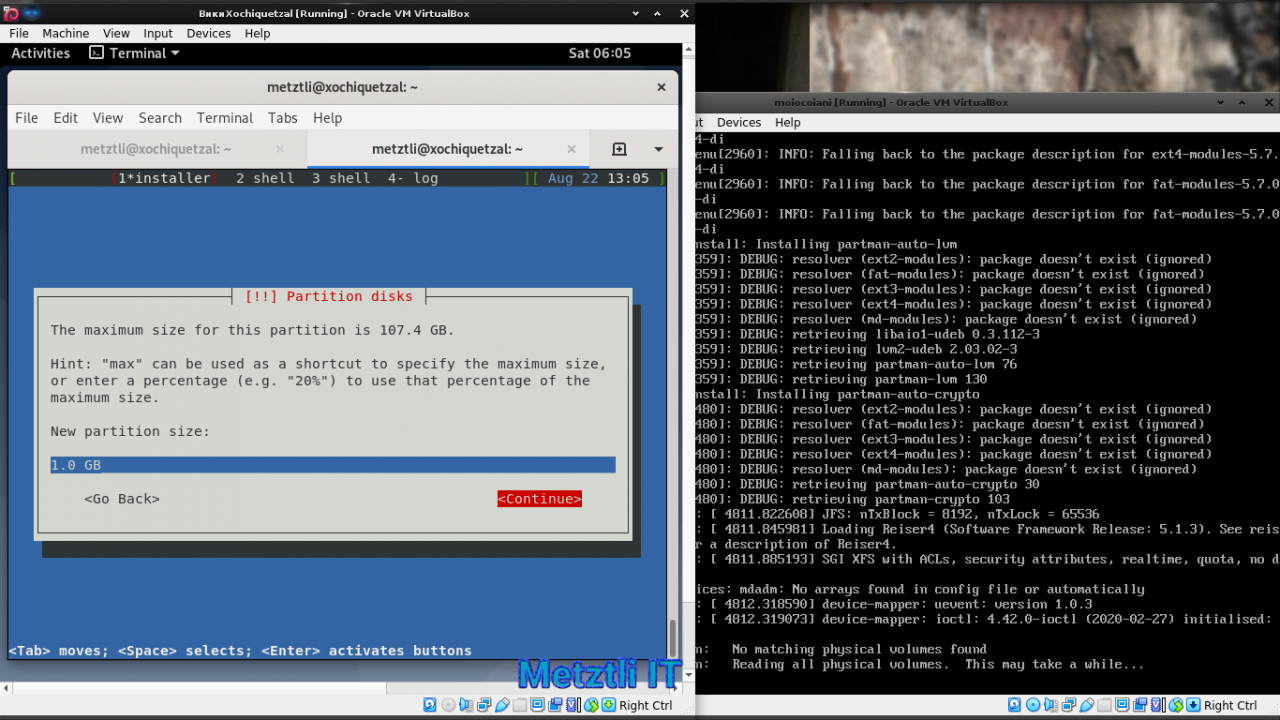
I further qualify the creation of one(1) GB partition by specifying that it should be placed at the beginning of the storage device:

From the ensuing menu I modify default selection to specify that I want to use this partition formatted in JFS journaling file system:
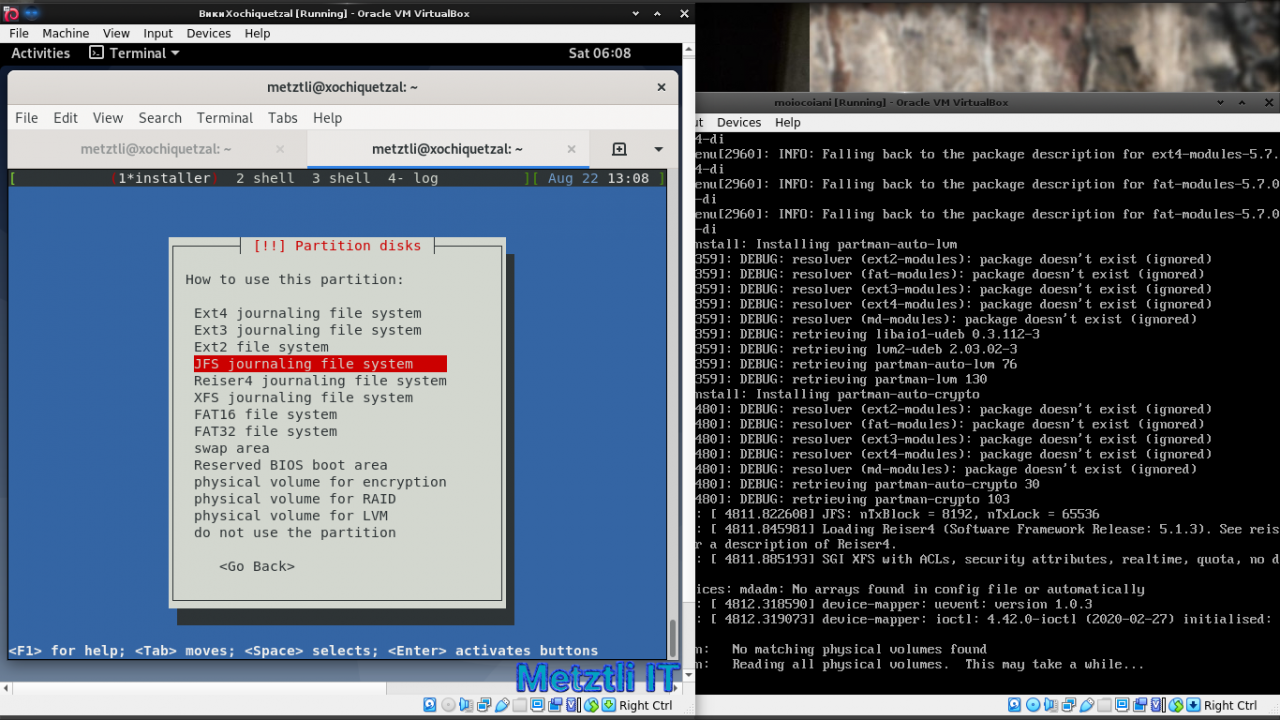
And further qualify my partition to use the /boot mount point at the subsequent dialog menu:
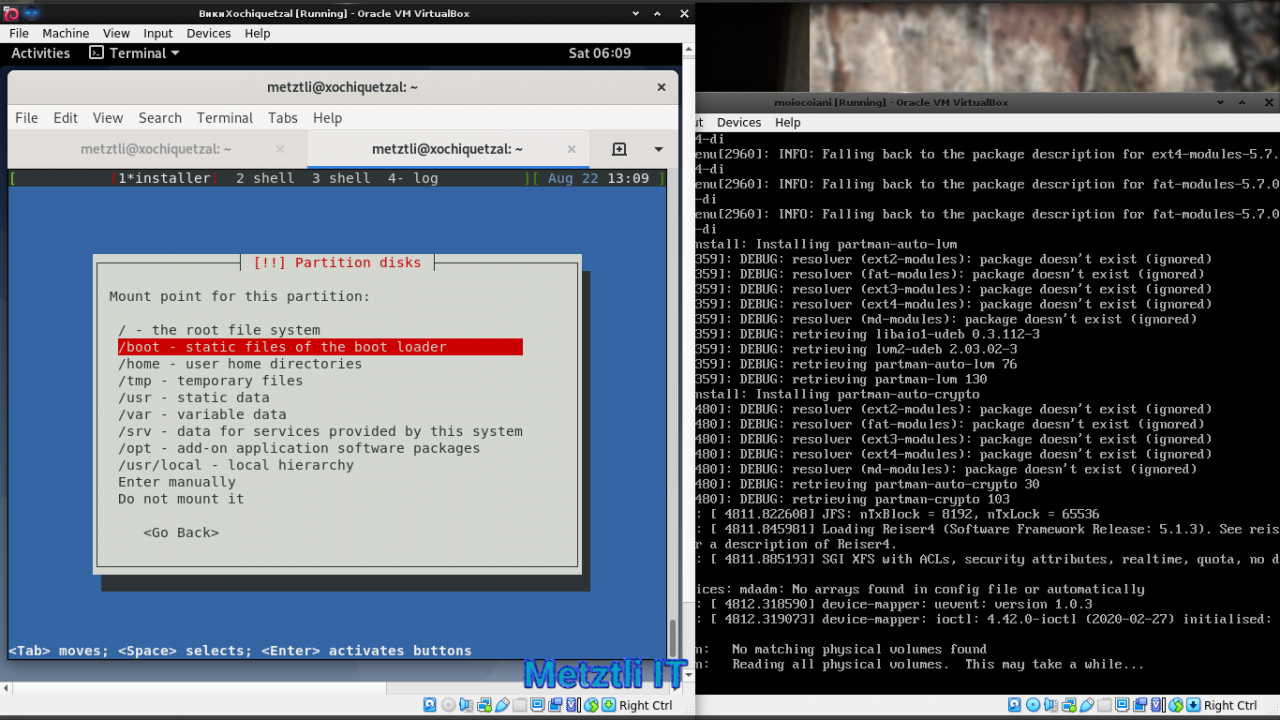
And finally I vest the name tlanelhuatl, i.e., base or foundation, on the partition, and attach an eponymous label -- with the only difference that the latter begins with first character capitalized.
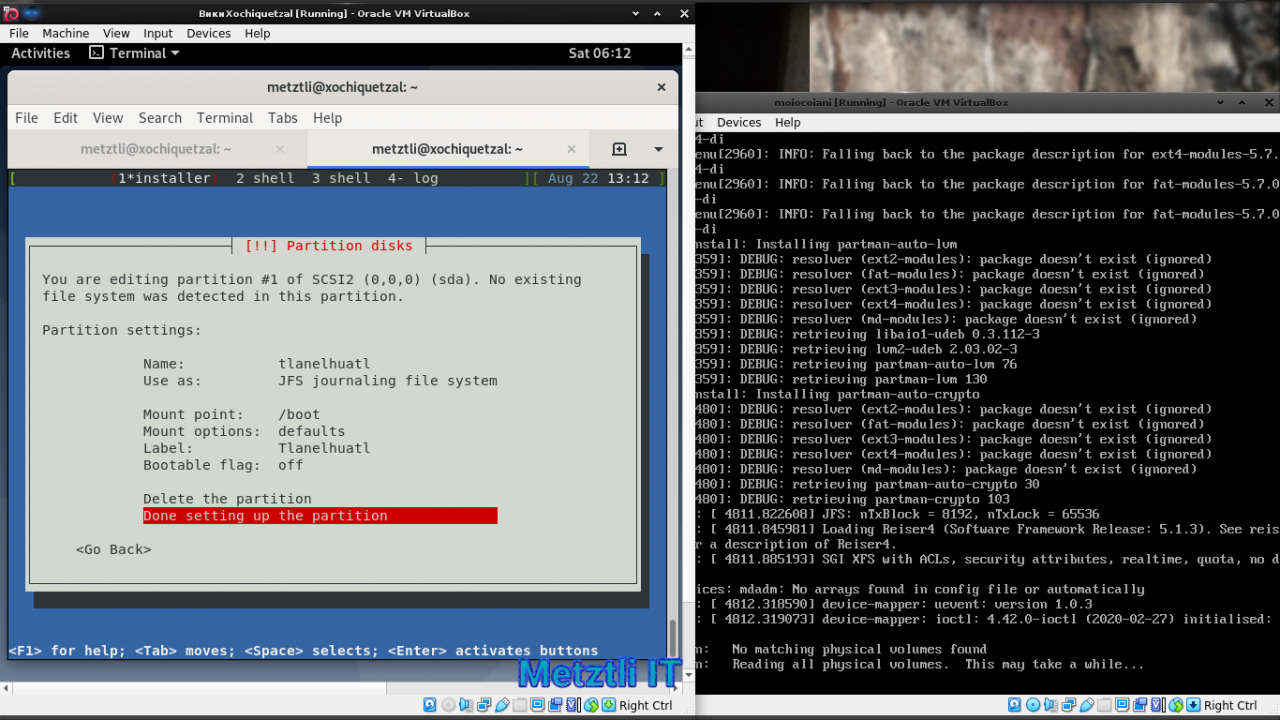
I move the red highlighting to Done setting up the partition
I proceed retracing the prior steps by selecting free space to create another partition, modify default size to four(4) GB, and locate the partition at the end of the storage device; however, this partition will be used as swap area:
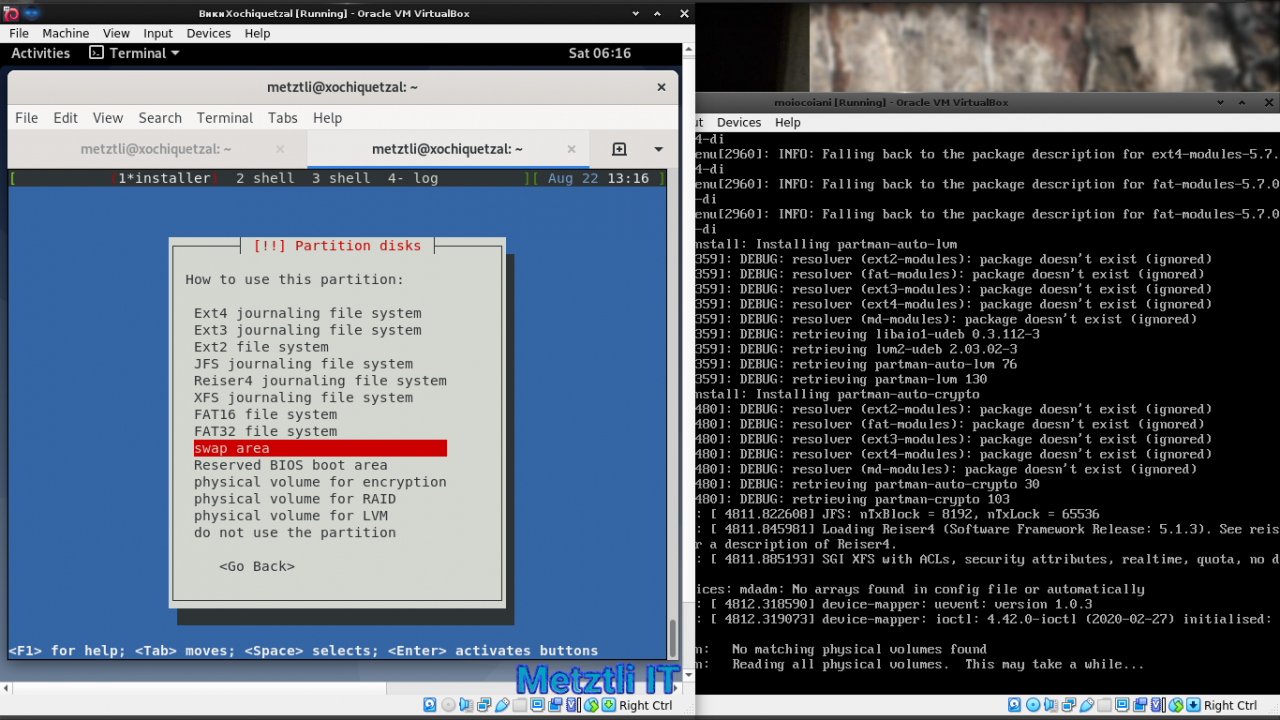
As before, we use the arrows in our keyboard to highlight Done setting up the partition over the ensuing dialog menu.

And lastly, I select the remaining free space in the middle of the storage device, from the Partition disks dialog menu:

Again, I highlight the Create a new partition from the ensuing dialog:
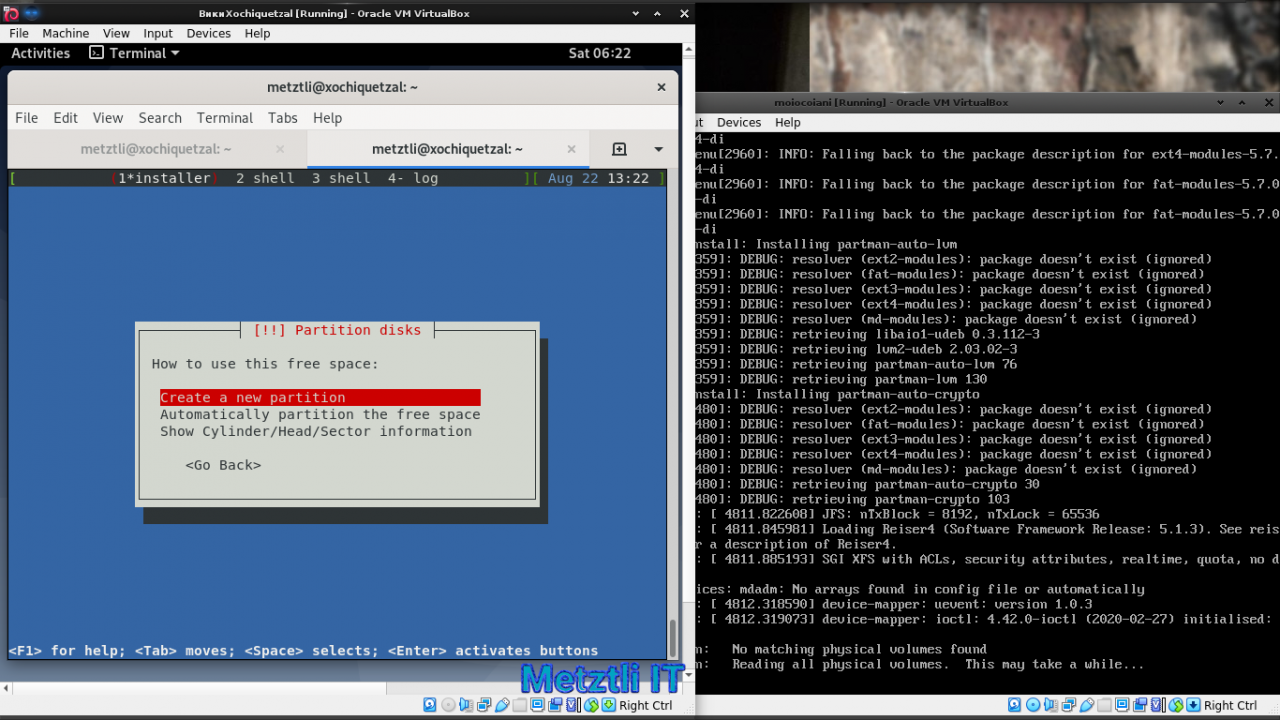
This time I leave the default as the New partition size which will be specified to be used as Reiser4 journaling file system in the subsequent dialog sequence.
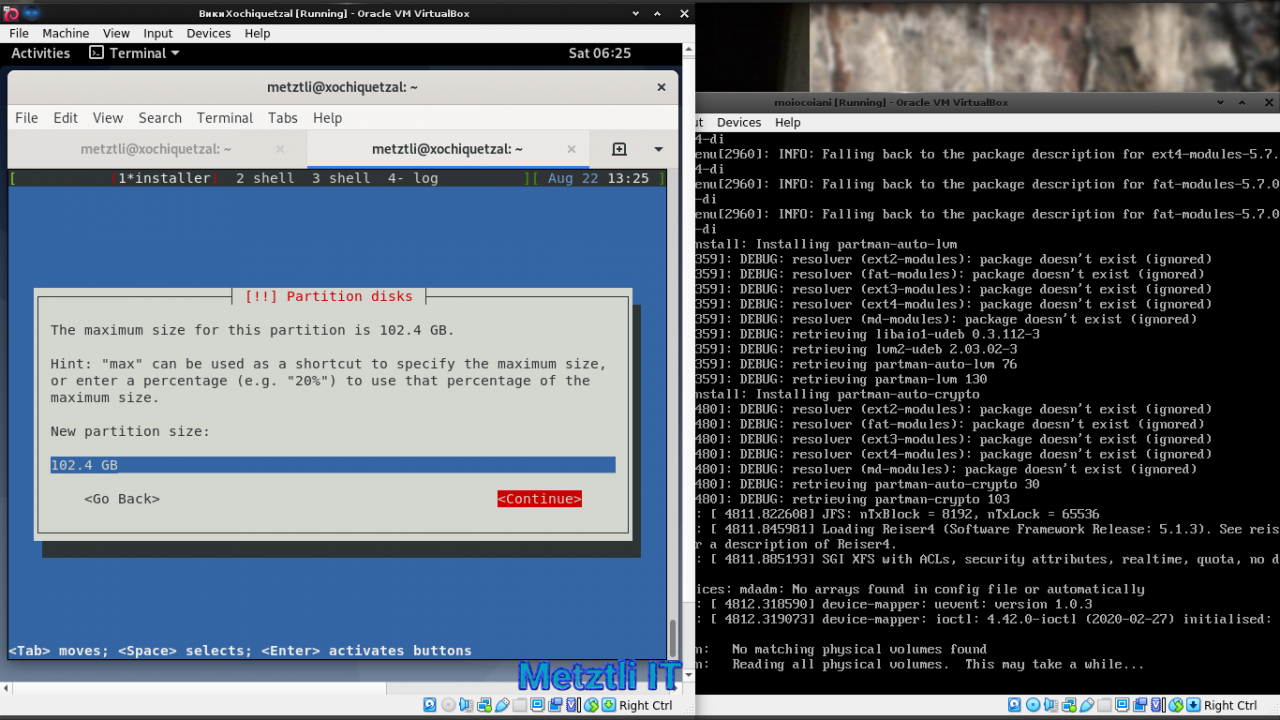
Accordingly, Partition settings with Reiser4, Software Framework Release Number (SFRN) 5.1.3, will be shown for our review as in the next snapshot. As I do not name nor label the Reiser4 journaling file system partition(s), I am satisfied with the settings and use the downward arrow to highlight the Done setting up the partition and press the Enter key.
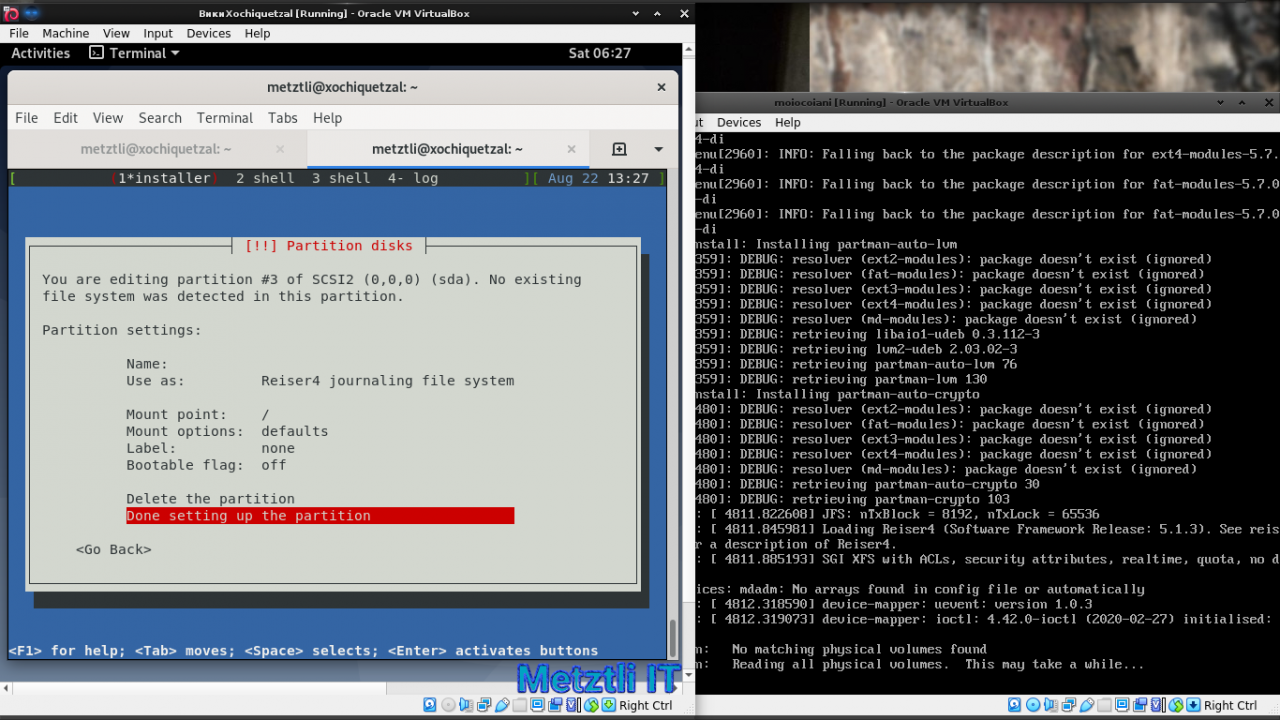
The installer returns to the main partitioning dialog menu, scroll down by pressing the downward arrow a couple of times, and highlight the Finish partitioning and write changes to disk
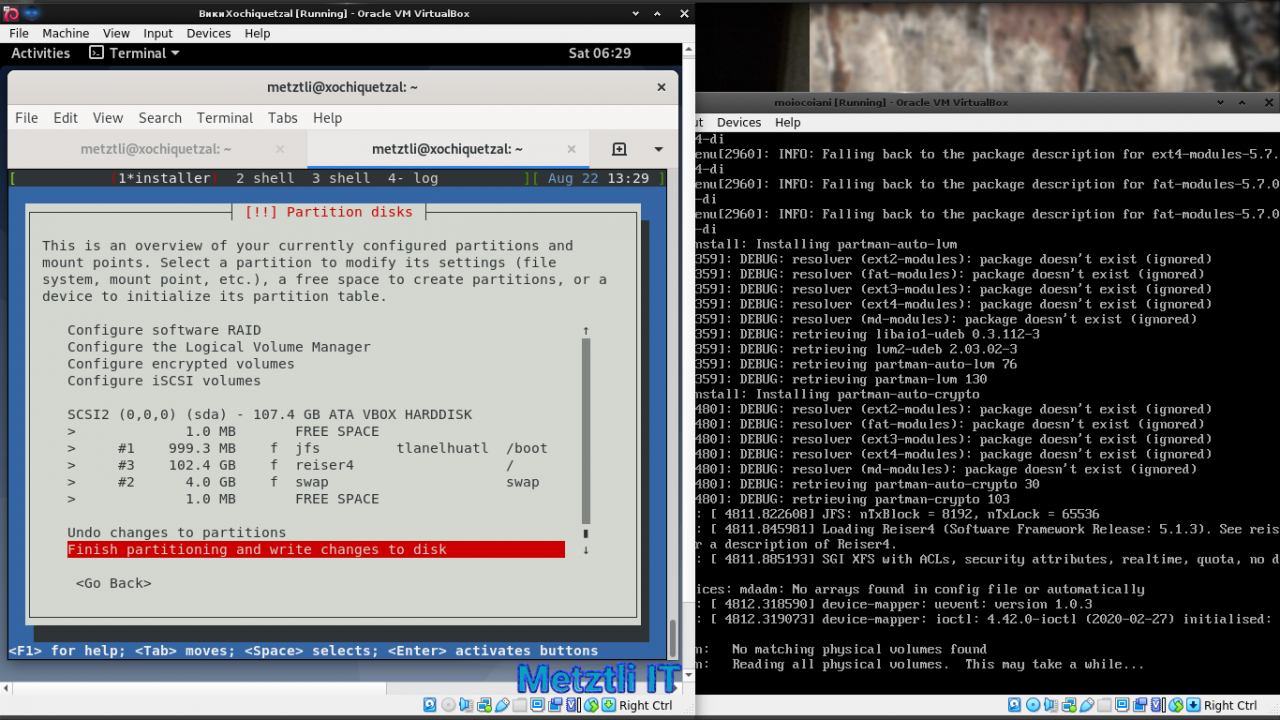
The final partitioning dialog in the sequence prompts us to verify our partitioning scheme before writing our changes to the storage device. Notice the default highlights the No setting -- providing a level of safety for those fast-finger-type individuals to rectify potentially destroying an unverified partition. Since I am fine with the partition tables summary shown I highlight the Yes button and press Enter.
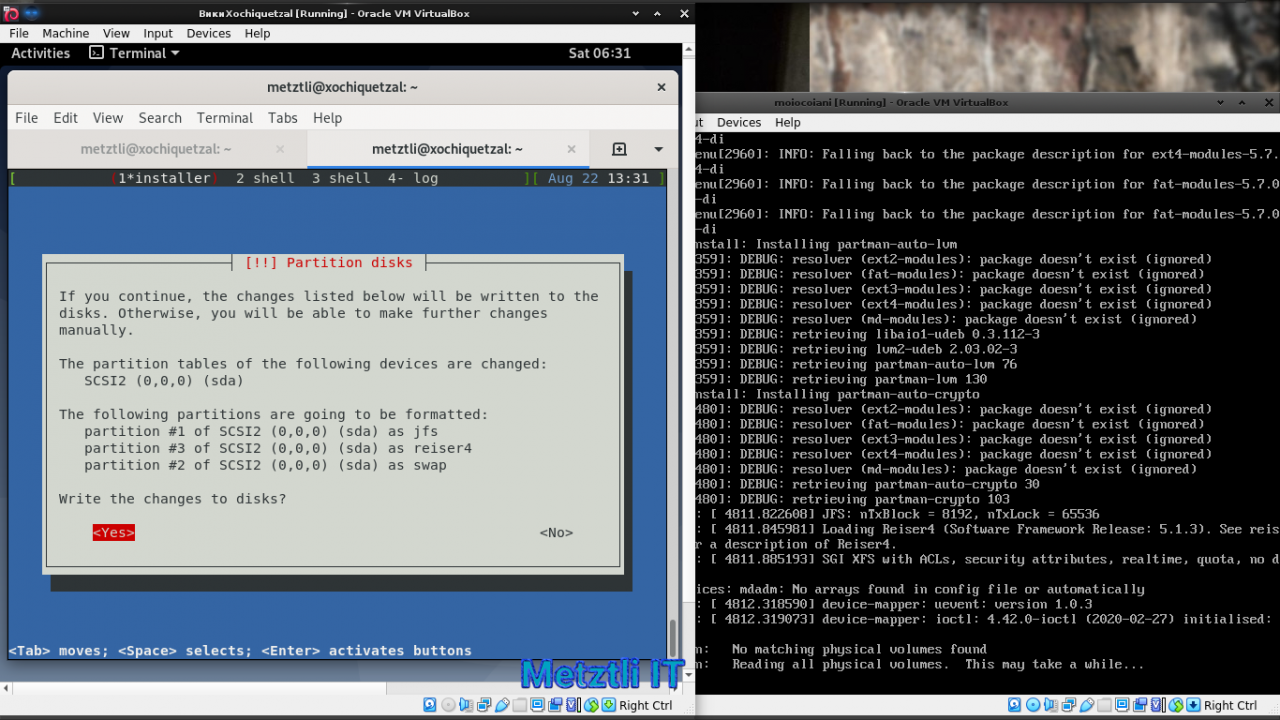
Returning to the Debian installer main menu the highlighting has moved to to Install the base system. A couple of points should be mentioned here. We can verify that Reiser4 SFRN 5.1.3, in effect, has been used to format the the target list selected and it is possible to manually provide different parameters than the bare default used by mkfs.reiser4 utility.
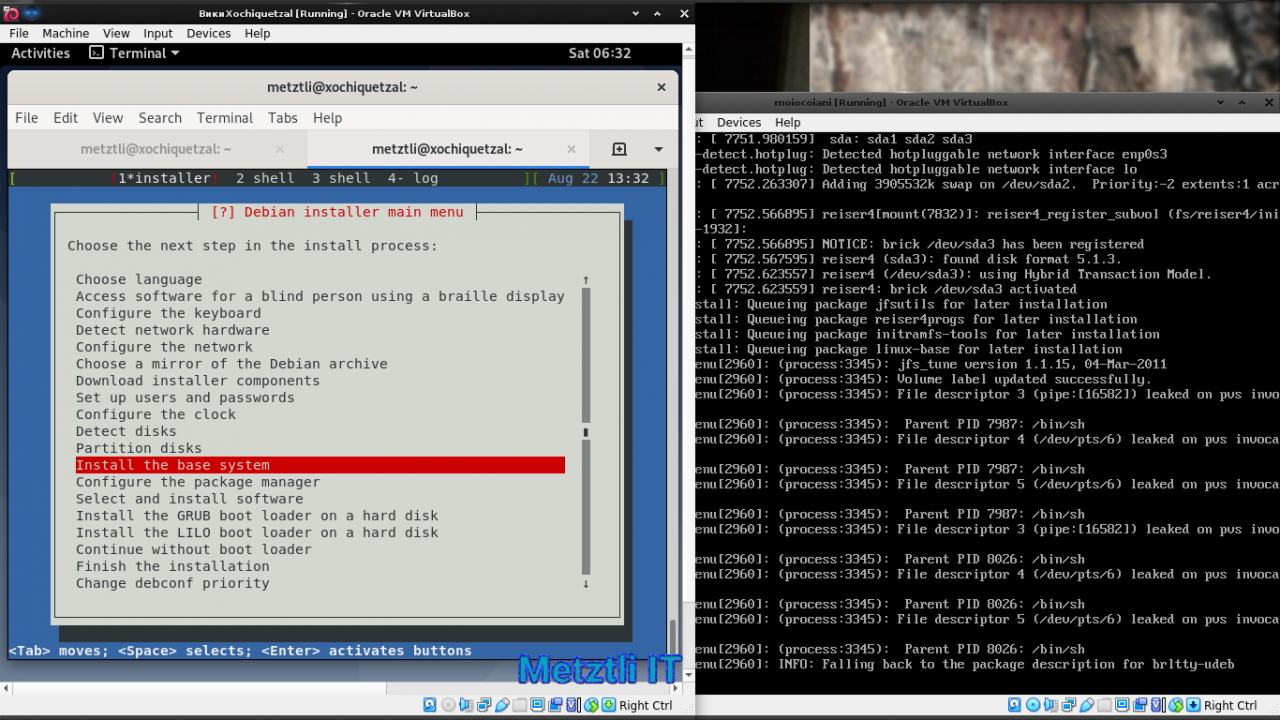
It is the case that Metztli Reiser4 SFRN 5 installer defaults to:
Shell
mkfs.reiser4 -yo "create=reg42" |
which, arguably, is adequate for an operating system installation onto a target partition of some 100 GB to 200 GB which will be used as a control platform for subsequent brick creation and manipulation for your cloud and or physical provisioning in your data centers.
In effect executing,
Shell
volume.reiser4 -l |
will output your current Volume ID and Brick ID, in addition to the reiser4Progs version and software format release number.
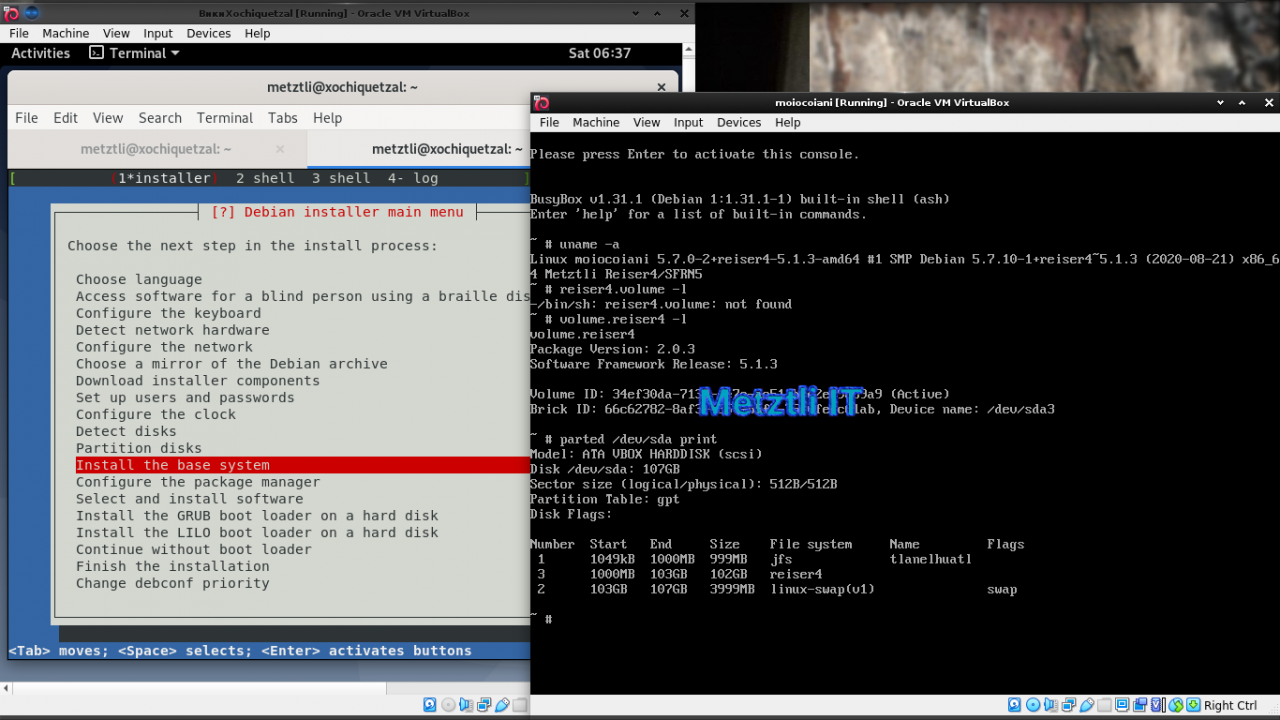
Notwithstanding, should different reiser5 parameters be desired to create and format our Linux operating system target partition, all one needs to do is create a tar archive at this point. With the exception of the important /target/etc/fstab, there will be only a few mount points and symlinks. Accordingly, from the current installer environment we are enabled to create a small TAR archive:
Shell
tar -cvpf target.tar /target |
We make a note of the existing devices and mount points, which in our particular case, are /dev/sda3 mounted on /target and /dev/sda1 mounted on /target/boot . Subsequently umount those devices, enter the reiser5 parameters desired to create your Linux operating system target brick.
After you are done, mount /dev/sda3 at /target and /dev/sda1 at /target/boot; untar target.tar . Use blkid utility to detect the changed UUID ; you may want to append its output into /target/etc/fstab:
Shell
blkid /dev/sda3 >>/target/etc/fstab |
Use xvi text editor (included in the installer) to modify /target/etc/fstab and replace the original installer created UUID with your new UUID that you appended at the end of /target/etc/fstab ; save your modifications and exit xvi text editor.
Reiterating, the above steps are provided only for more advanced users who have become acquainted with reiser5 parameters and desire to implement those in their target Linux operating system installation partition.
Moving on. Press CTRL+ALT+F1 (or equivalent in a virtual environment) to return to the installer main menu, which should still be at the highlighted entry Install base system, waiting for us to press Enter to continue. Do it.
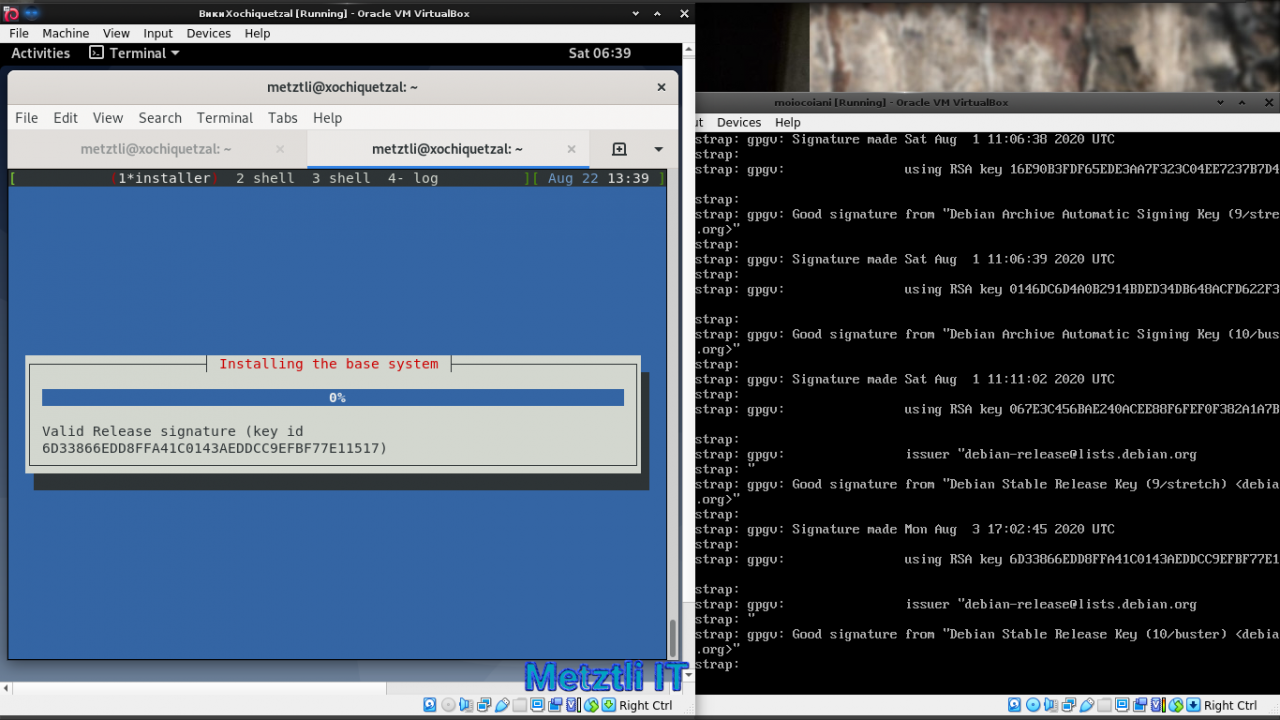
Another snapshot showing the advancement of the base system installation...
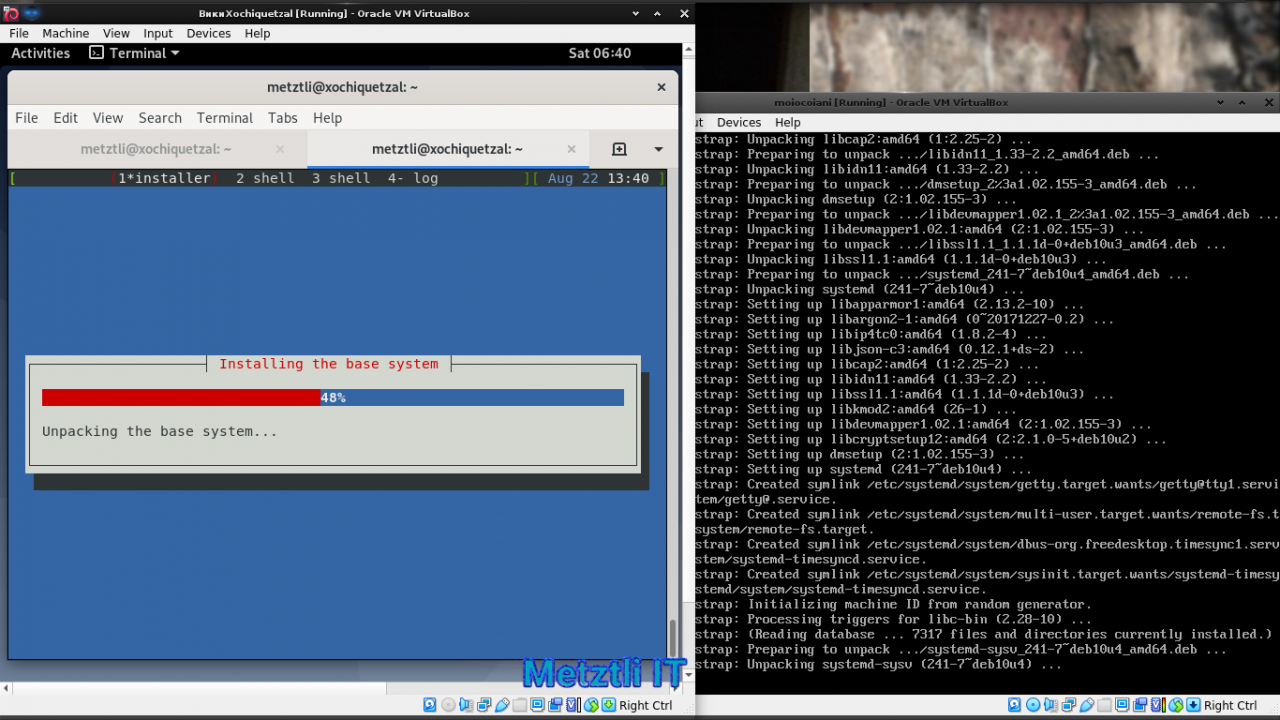
Installer subsequently shows a dialog showing the list of kernels available for installation. Metztli Reiser4 SFRN5 kernel should already be highlighted, but if not, please manually select it using your up/down arrows in your keyboard.
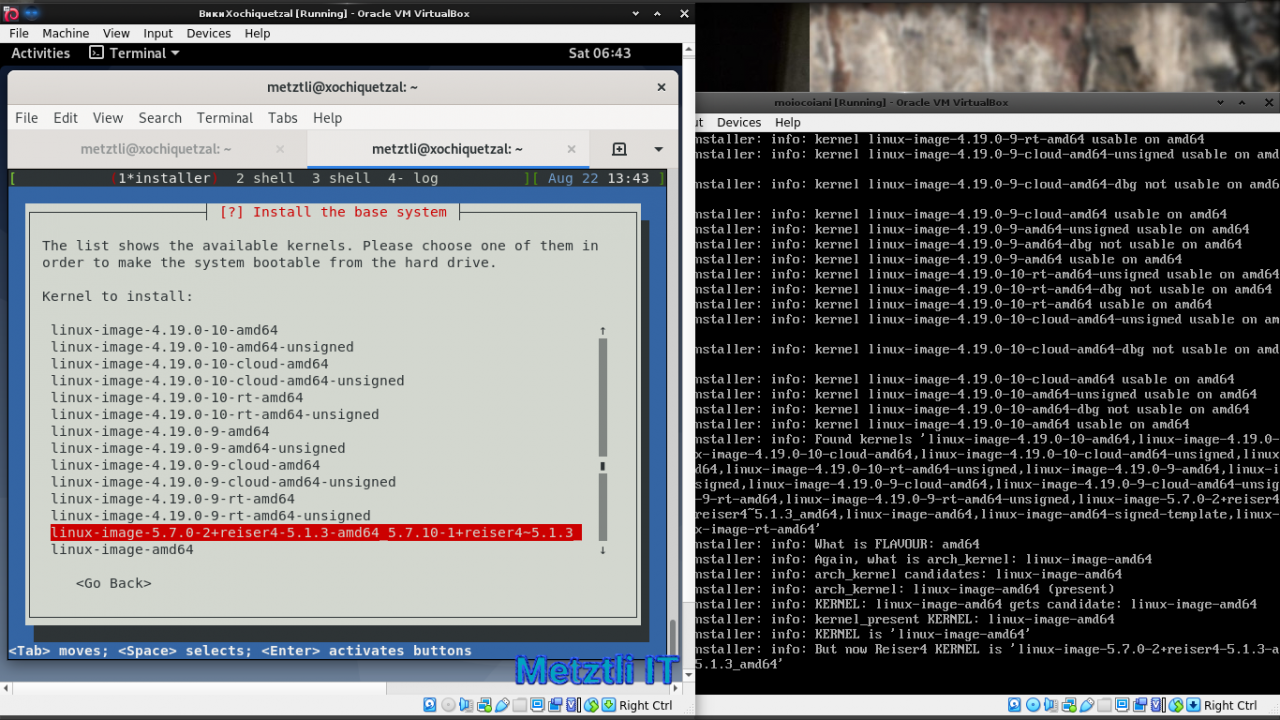
Select a generic, i.e., greater size due to the inclusion of non-targeted drivers, or targeted initrd. Please read the entire message shown in the dialog. I selected generic; the base system installation proceeds.
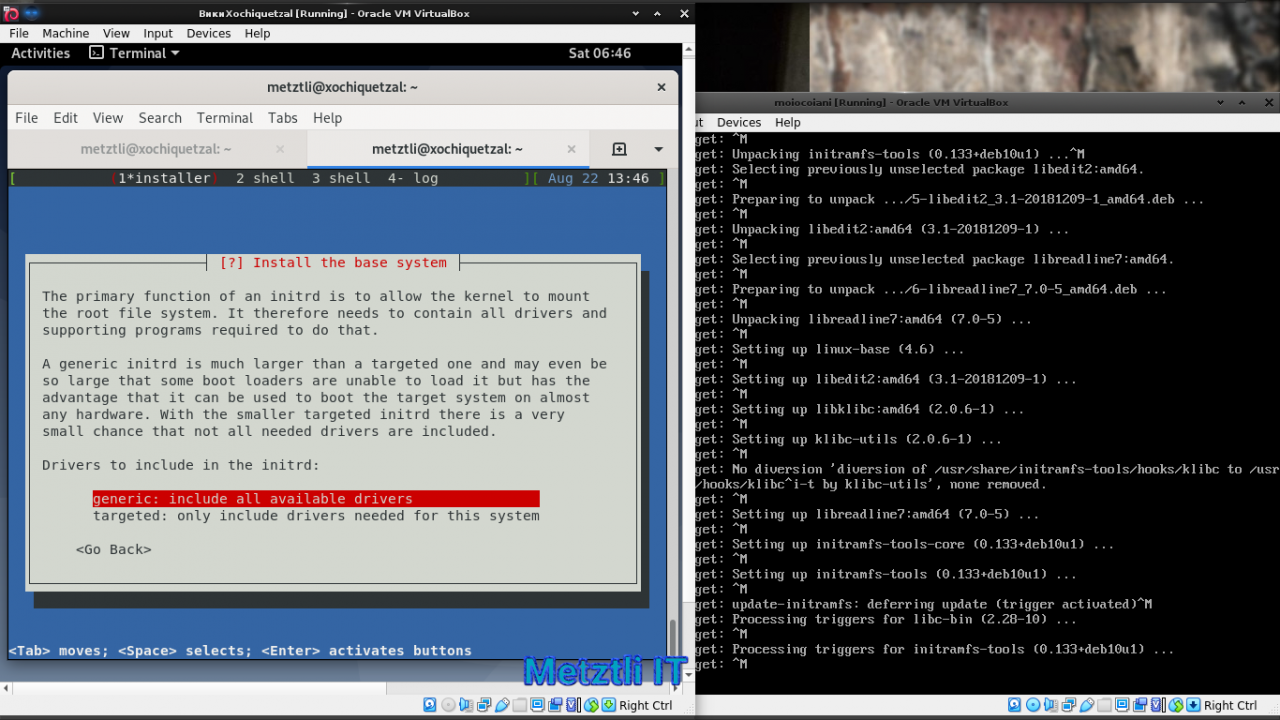
As the base system installation nears completion, the installer shows the jfsutils being installed; yet, under the dialog GUI, the output shows that initramfs-tools has been upgraded to Metztli Reiser4's Zstd- compressed enabled version 0.136. And the SFRN 5 initrd is being updated.
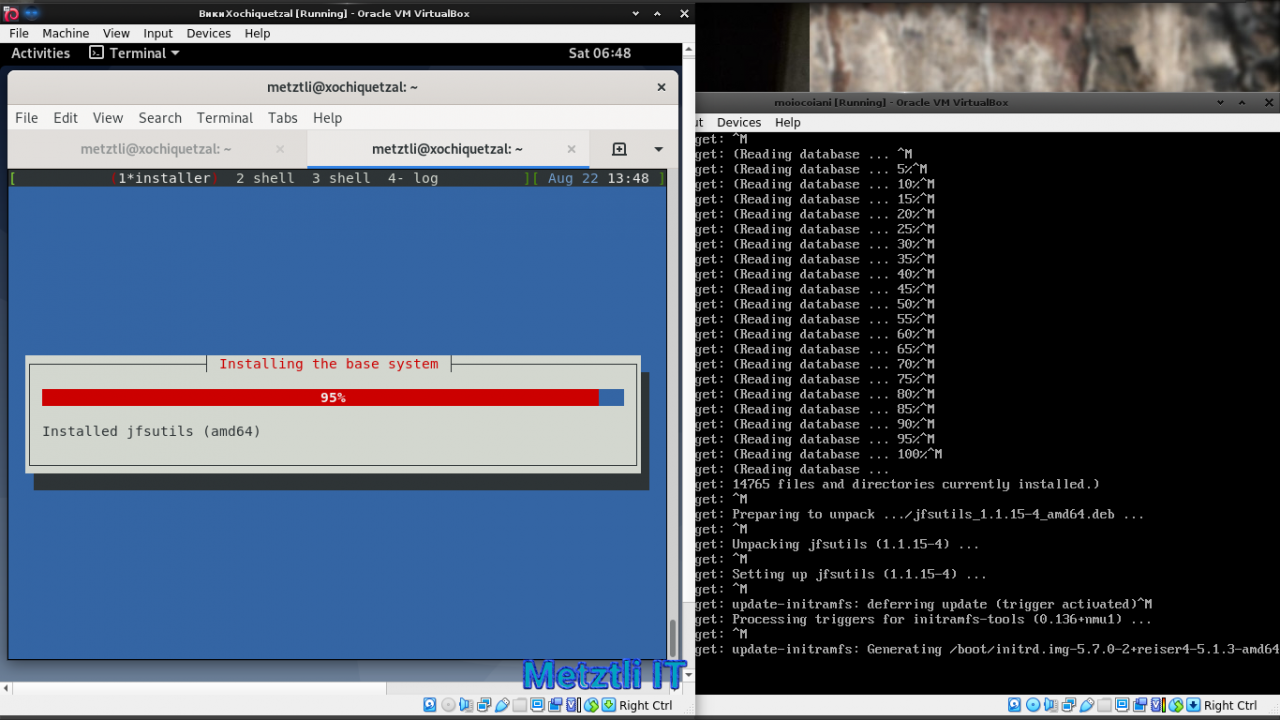
The main Debian installer routine menu returns suggesting the next task to be performed highlighted:
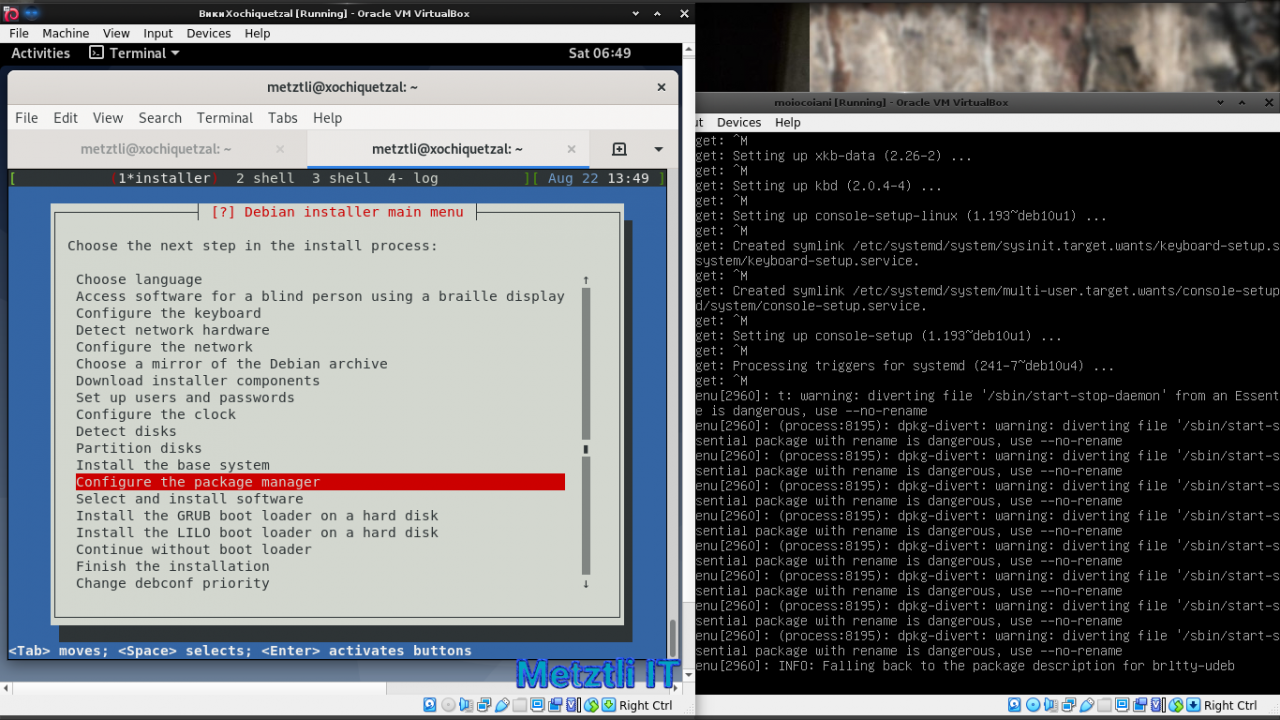
Pressing Enter installer routine advances to the next dialog. Since this installer contains non-free firmware, you might as well select yes to having available non-free software, but...
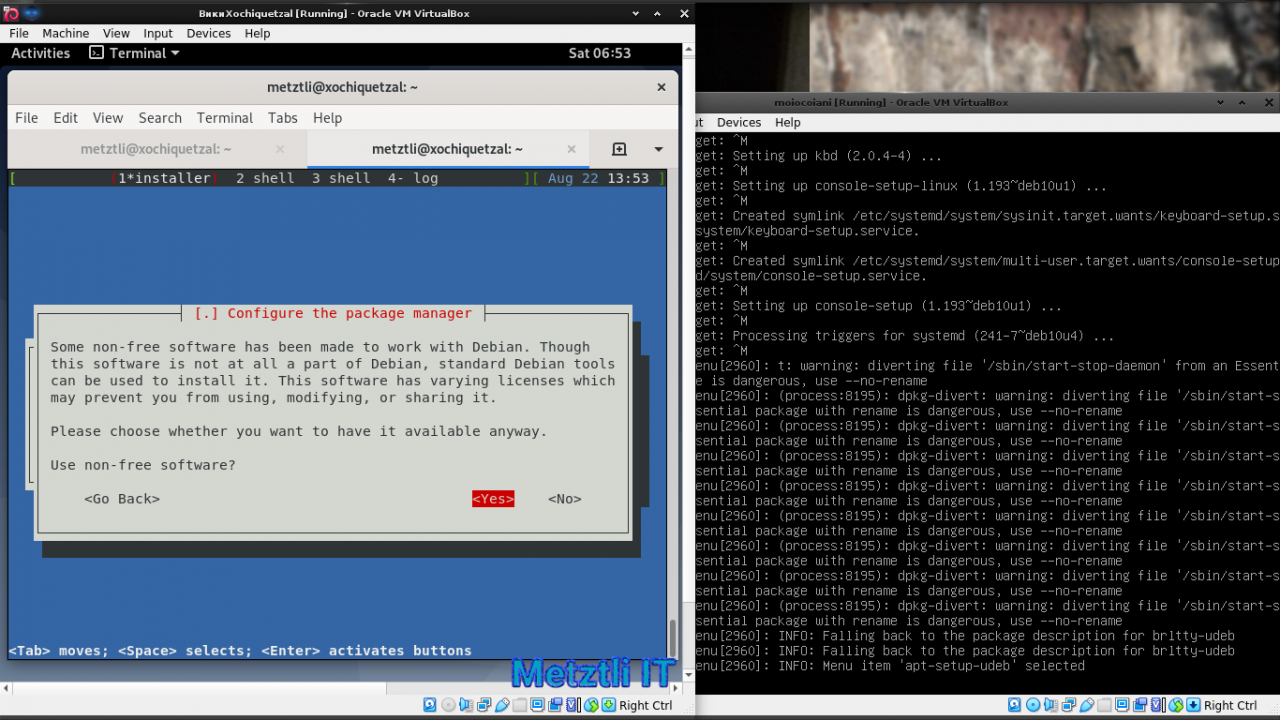
The ensuing dialog has more relevance to those with an inclination to develop software:
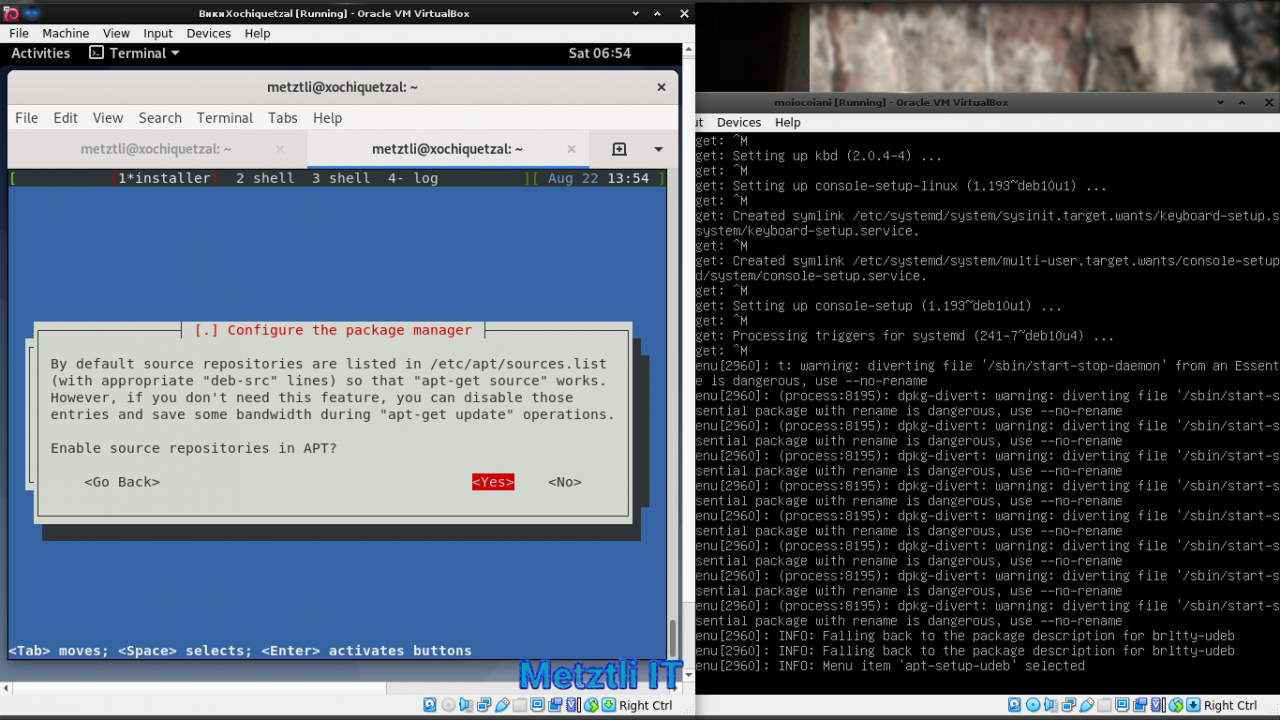
Subsequent dialog explains Debian context on security and release updates, as well as on backported software, so that user can make an informed decision in still to come dialog options.
Please, note that Metztli Reiser4 SFRN 5 makes extensive use of backported software and automatically inserts a relevant line for non-expert installation -- and even for expert installation if the option is overlooked.
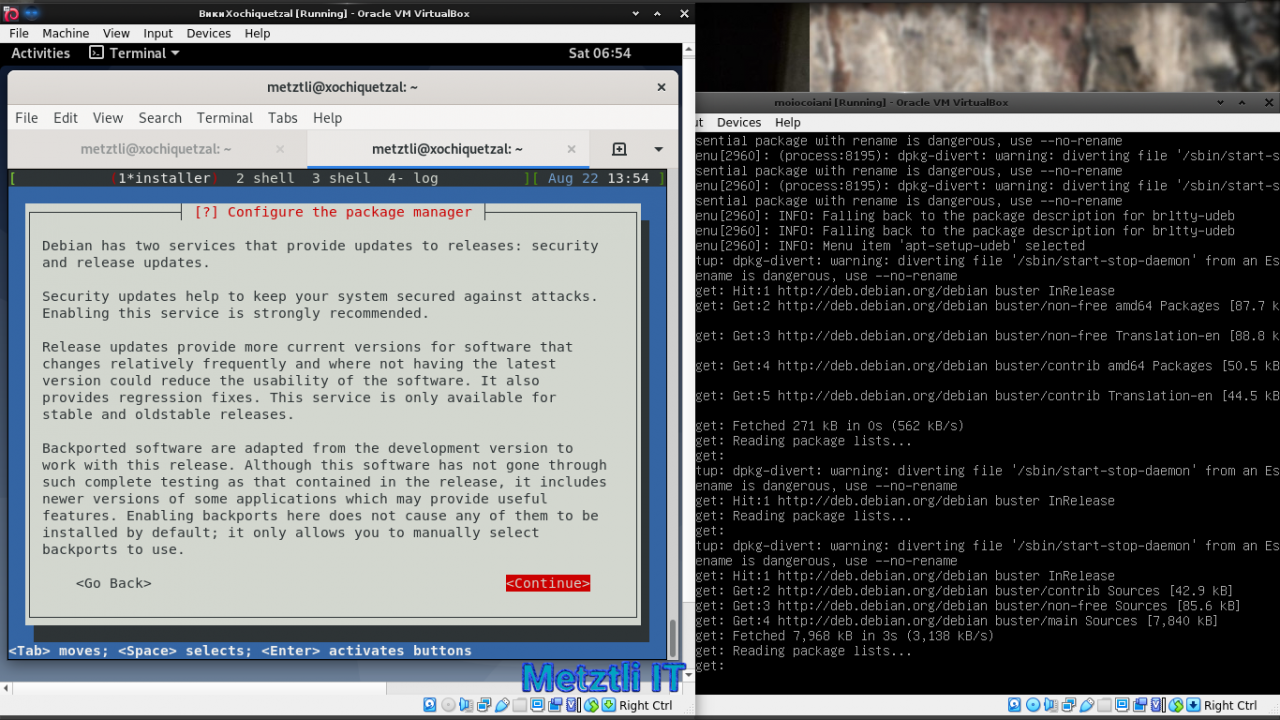
Next dialog show the options discussed immediately above:
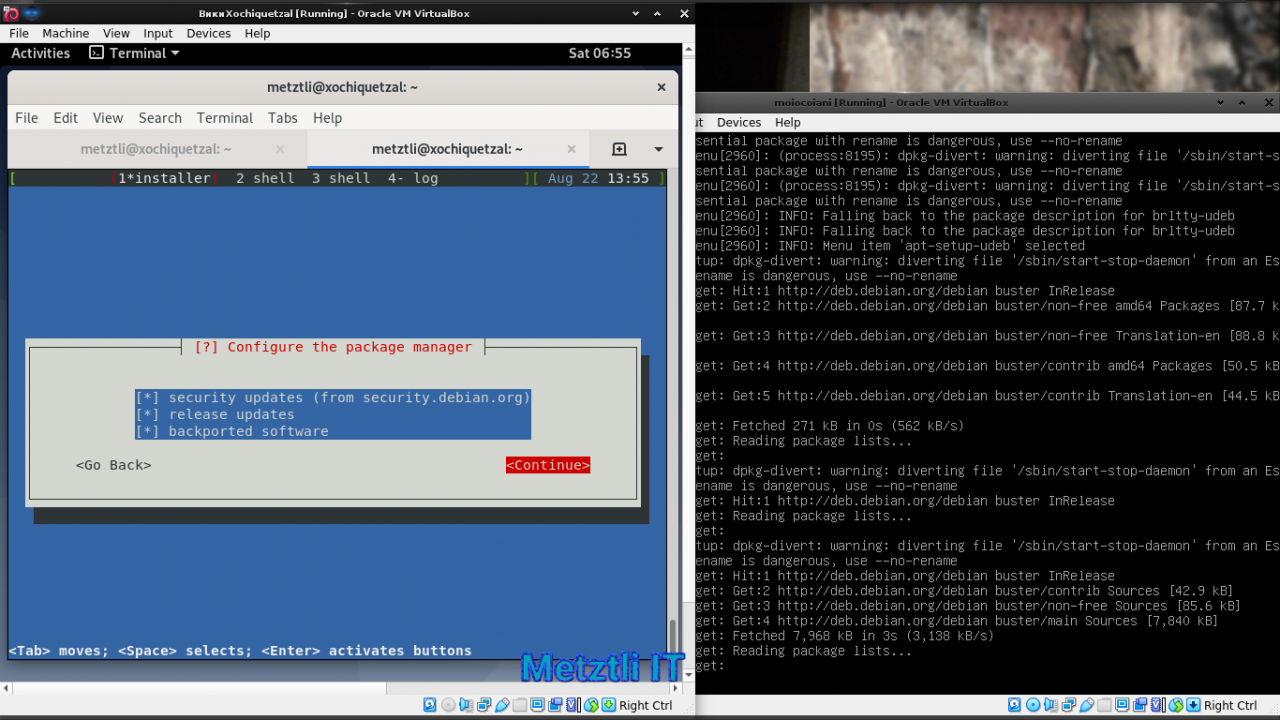
Now, depending upon the level of control an administrator needs over this server once it is installed, she may want to review forthcoming security updates prior to installation in case her manual intervention may save her a headache due to potential software incompatibilities.
This is especially true of online, cloud or physical, servers where an automatic security update may halt the database or an essential service. It happens -- so please decide judiciously.
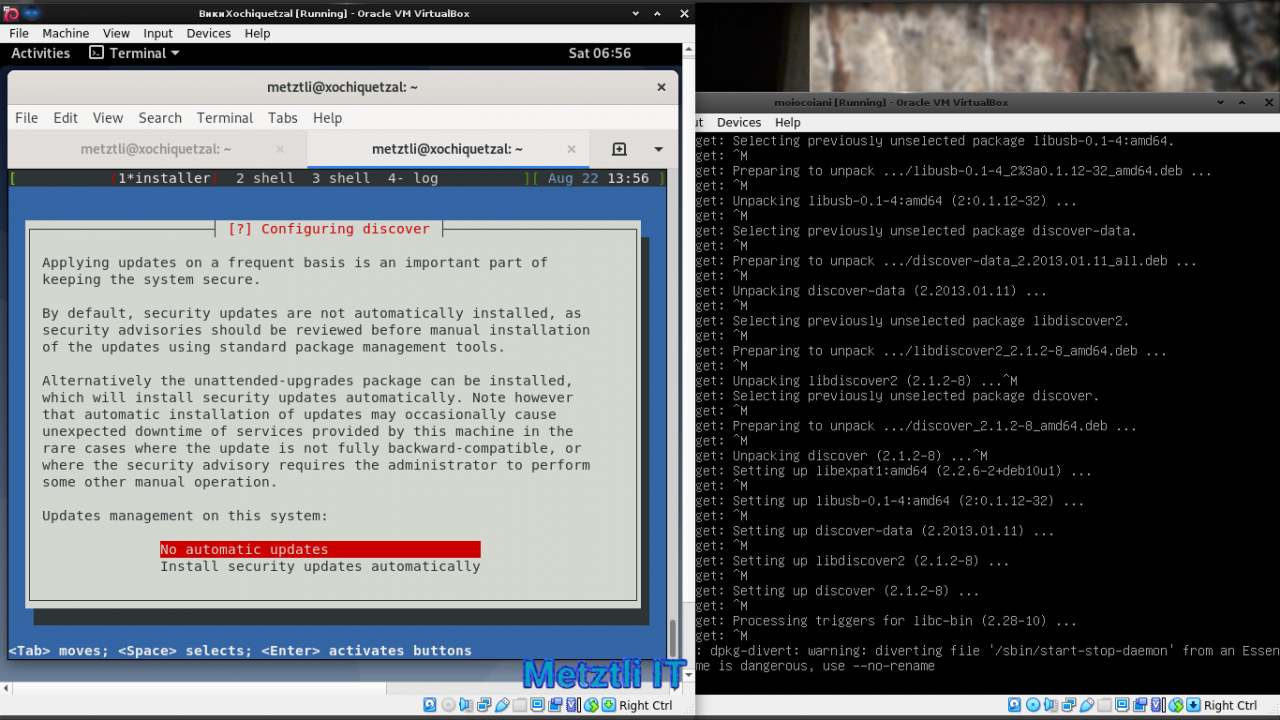
Debian main menu routine returns, advancing suggested next task to the highlighted entry:
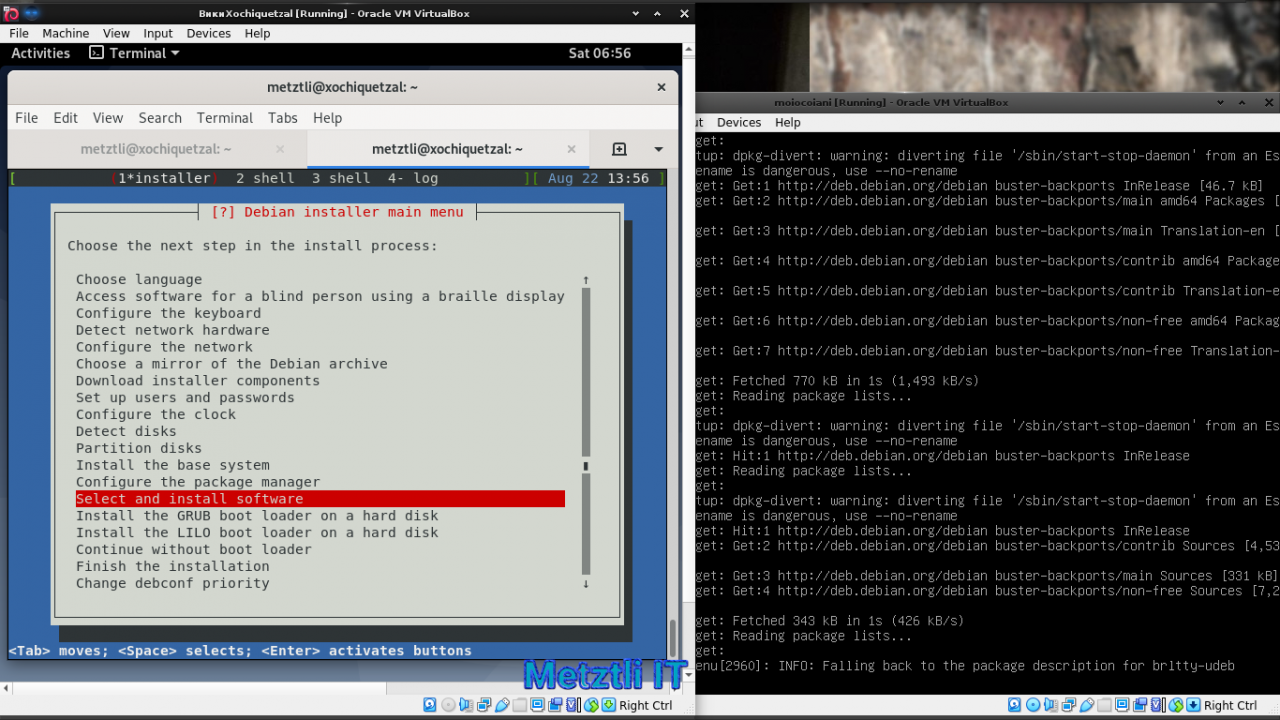
You may want your server to participate in the package usage survey where your server will automatically provide package information, anonymously, on a weekly basis to the distribution developers; they in turn will use the data collected to prioritize the inclusion of packages in their installation media. The data collectively submitted can be found at the Debian Popularity Contest site.
Your choice can be later modified by acquiring root privilege and typing the directive:
Shell
dpkg-reconfigure popularity-contest |

Predefined collections of software will enhance your core system with the tasks you intend this machine to perform. If it will be a server on the cloud and/or physical server at a hosting provider's farm, a GUI will likely not be needed, but you definitely should specify SSH server for you to connect to it.
On the other hand, if this is an installation for an user who will be physically at the machine doing computing tasks like browsing the Internet, editing documents, etc., please select your preferred Desktop GUI. For instance, a Debian desktop environment is essentially GNOME enhanced with Debian packages the Debian maintainers consider enrich the user experience and/or align with Debian philosophy.
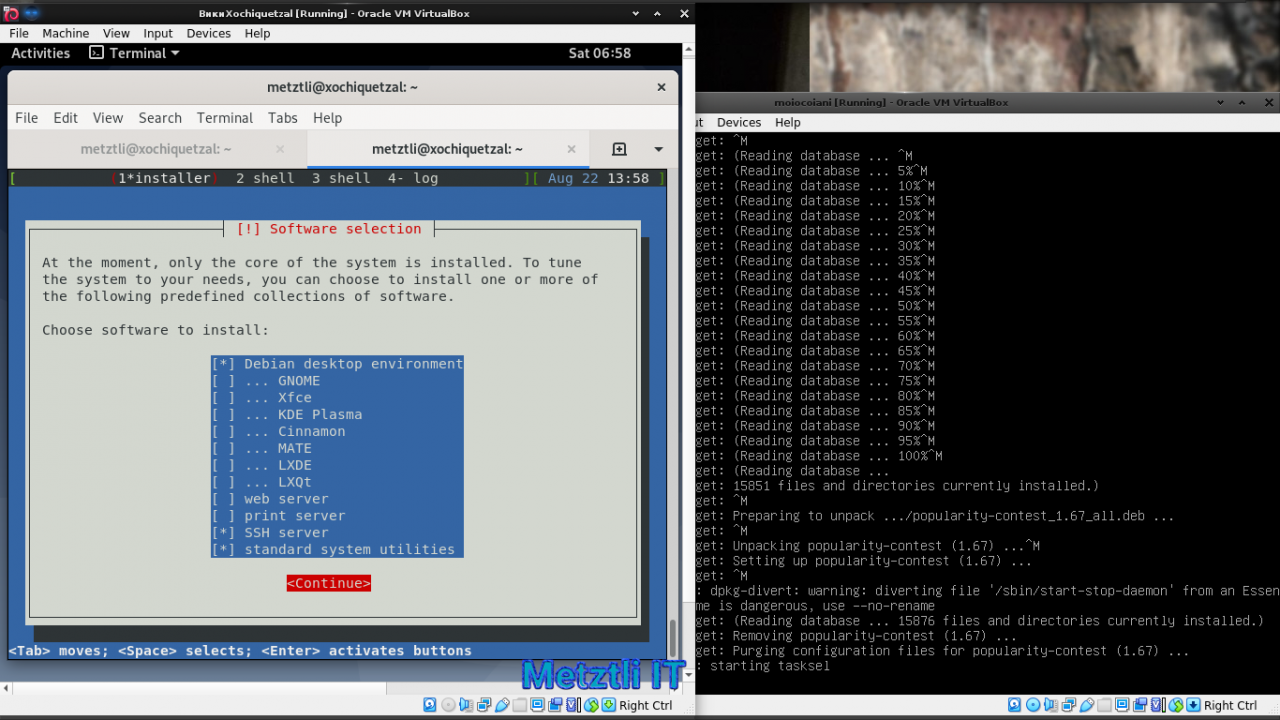
As the Debian installer routine completes installation of selected software collections, the main menu returns with the suggestion to install the default boot loader highlighted.
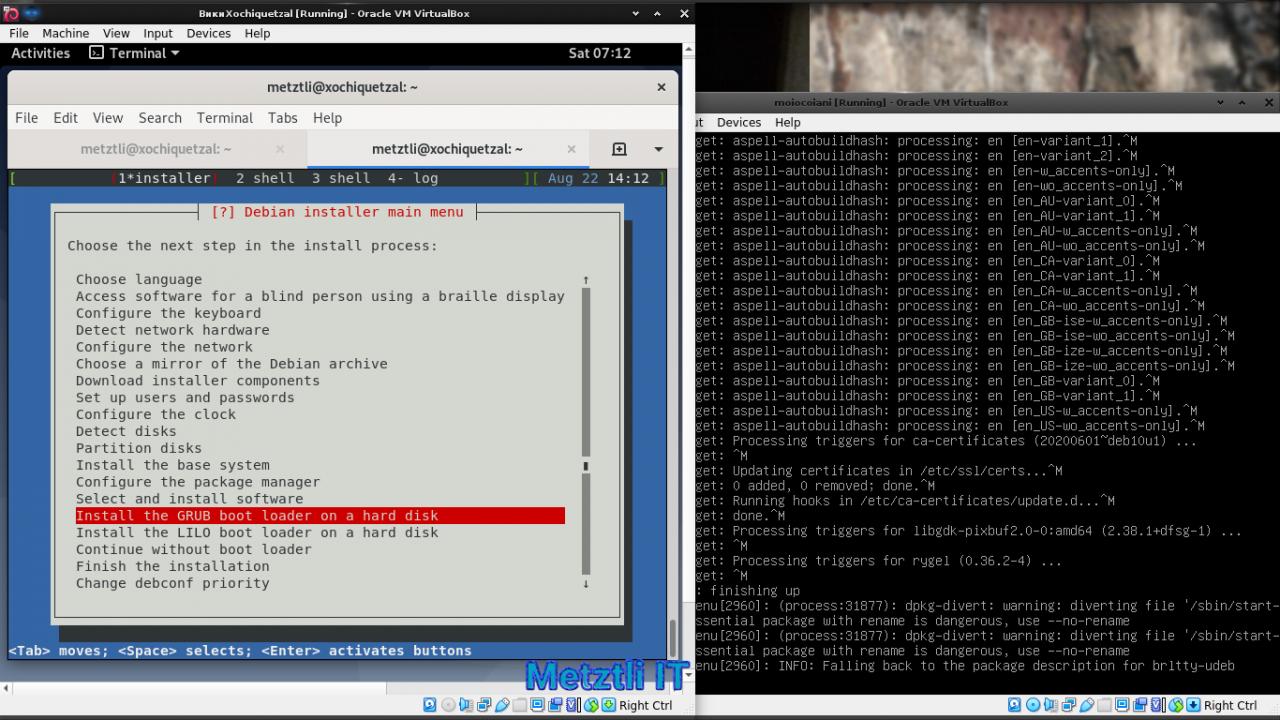
I you are installing this system on an environment where other operating systems exist and were not detected, please make sure you will be able to recover if installing GRUB to the master boot record may ephemerally rend unbootable those other systems.
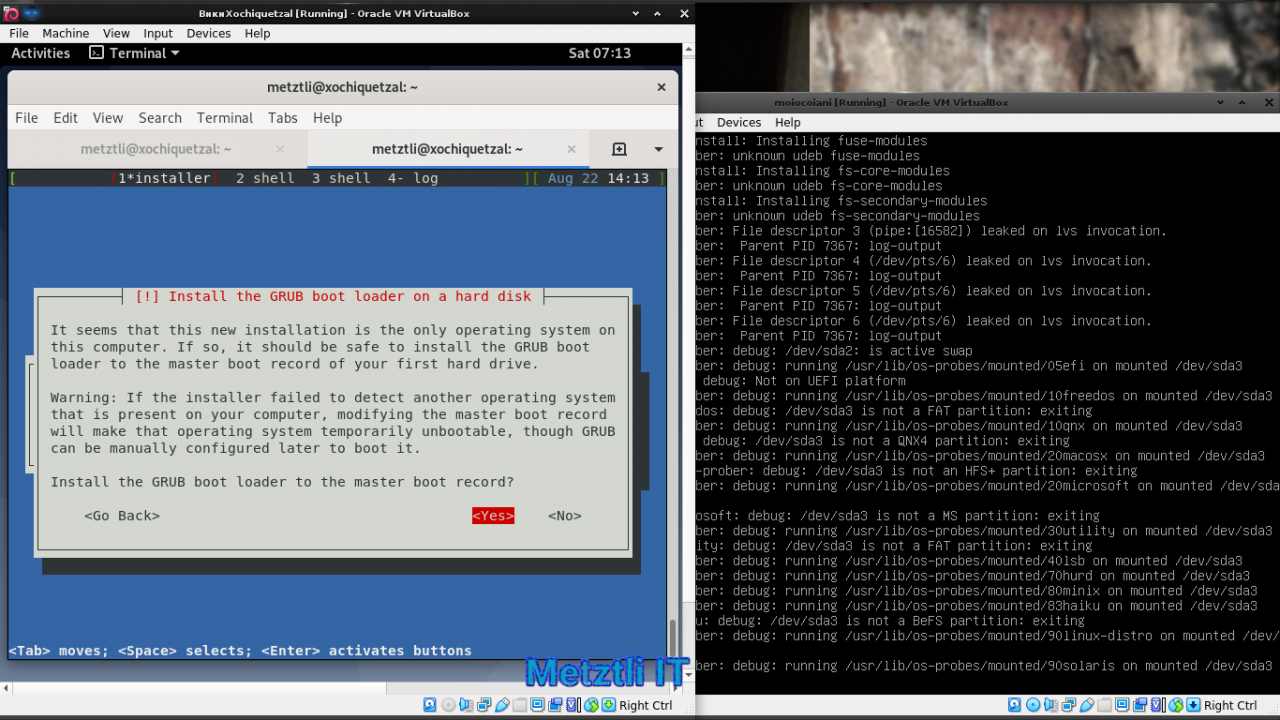
The next dialog prompts for specifying the target bootable device where the GRUB boot loader will be installed.
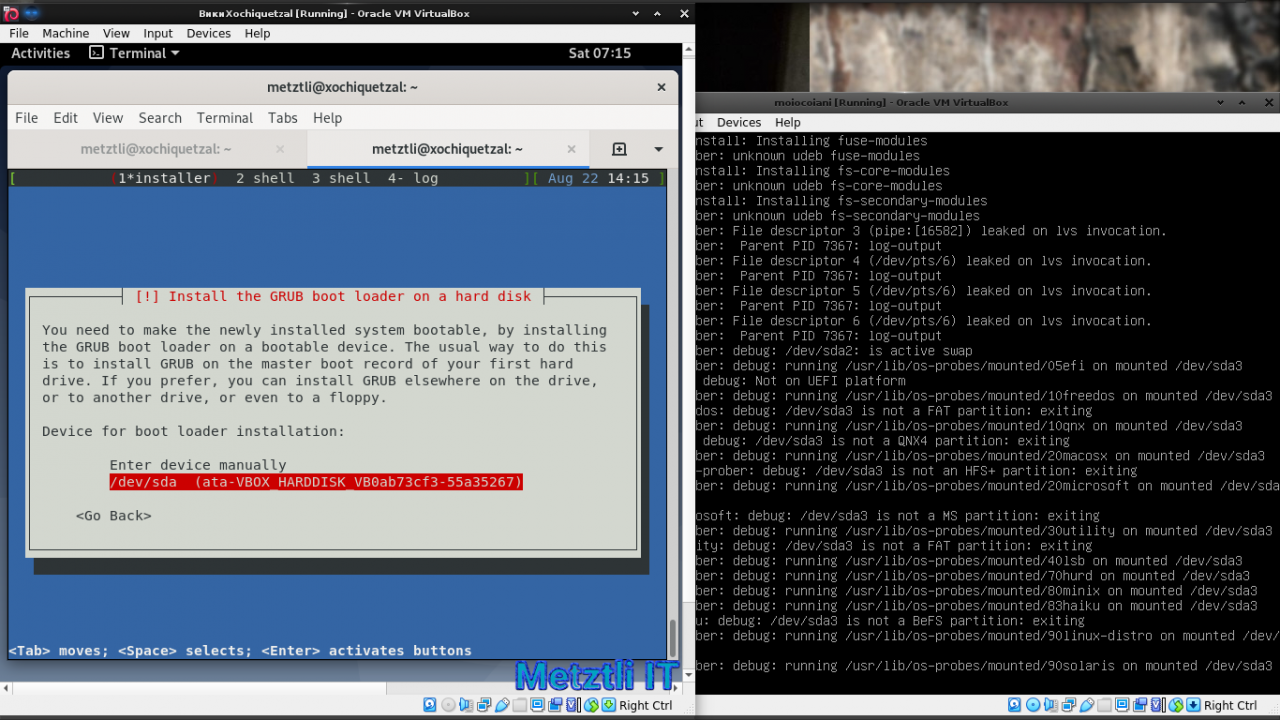
The final boot loader relevant dialog relates to Extensible Firmware Interface EFI. Please make sure to read and understand the implications of your choice. Be aware that the message may be misleading in the sense that although it guesses that 'this computer is configured to boot via EFI' which may not be the case as in my current installation. Thus, I select No to installation to removable media path.

Eventually the Debian installer routine highlights the end of Metztli Reiser4 SFRN 5 installation.

The installer prompts for user input acknowledging the system clock is set to Coordinated Universal Time (UTC) or local time.

And then the final dialog appears: Reiser4 SFRN 5.1.3 installation is complete... ![]()
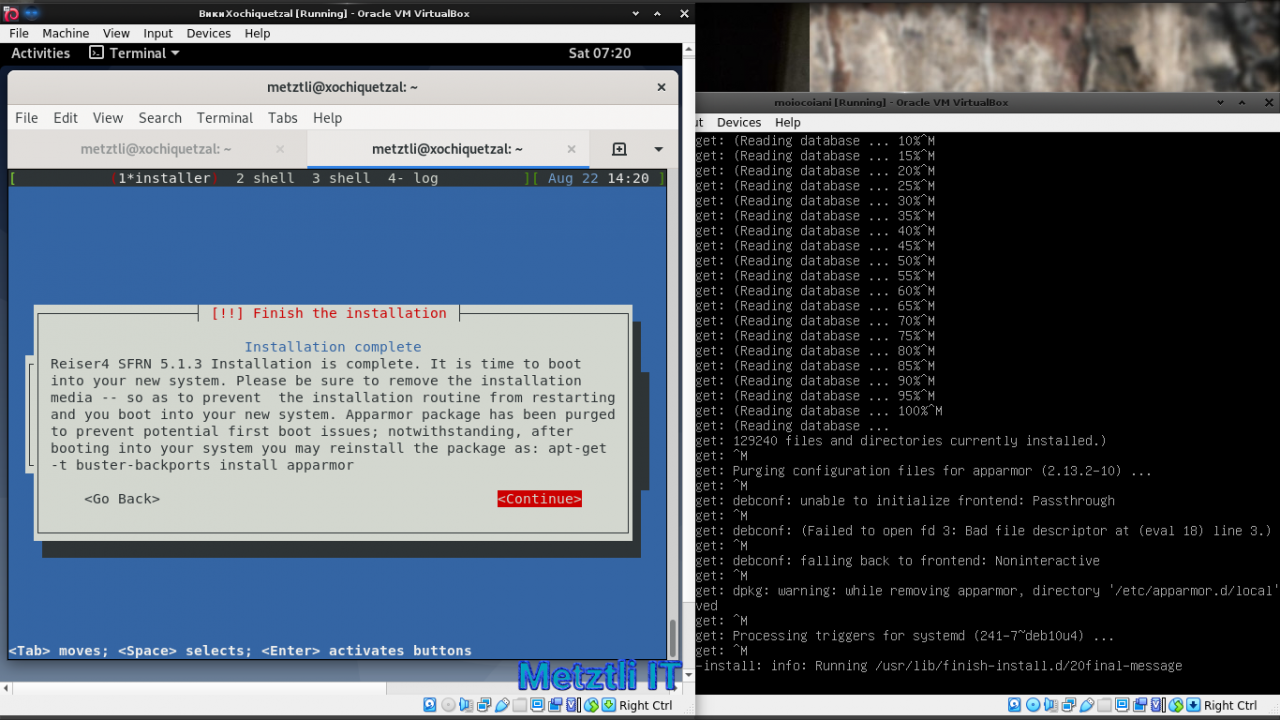
Please note that Apparmor package has been purged as from multiple installation experiences, especially with Desktop GUIs, the very first boot often hung the system. Understandably, the user would be frustrated; although all that was required was to wait until all the disks were checked and subsequently force a reboot. Notwithstanding, if the user interrupted the procedure during a disk still being checked, additional time would be required upon the next reboot. Accordingly, I found that by purging the Apparmor package the system boots adequately the first time and the user may simply reinstall Apparmor subsequently.
After removing Metztli Reiser4 SFRN 5 installation media, I press the highlighted option to continue and the system reboots. The client machine where the installer was being displayed is disconnected from the sever where the installation was being performed -- as the latter now is about to reboot.
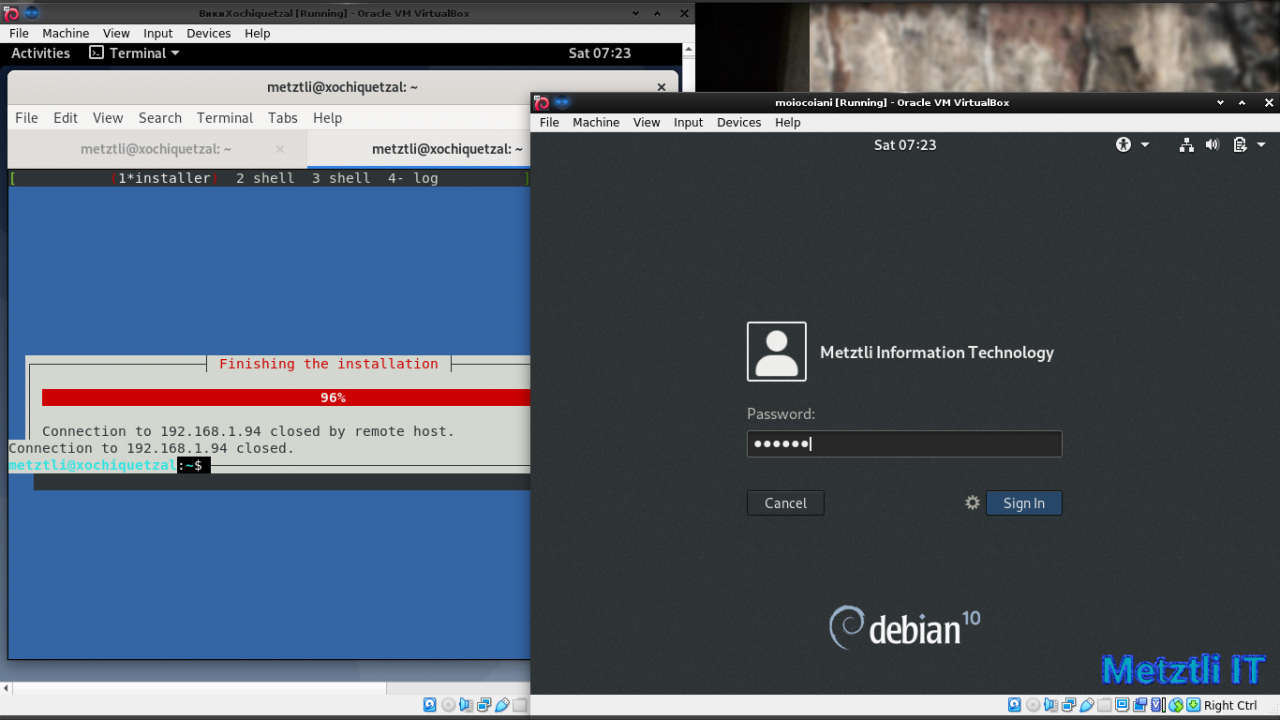
Upon booting into my Reiser5 system, I open a GNOME-Terminal emulator command prompt, change its background color, and show that it is the same brick and volume that we peeked into during the installation procedure.
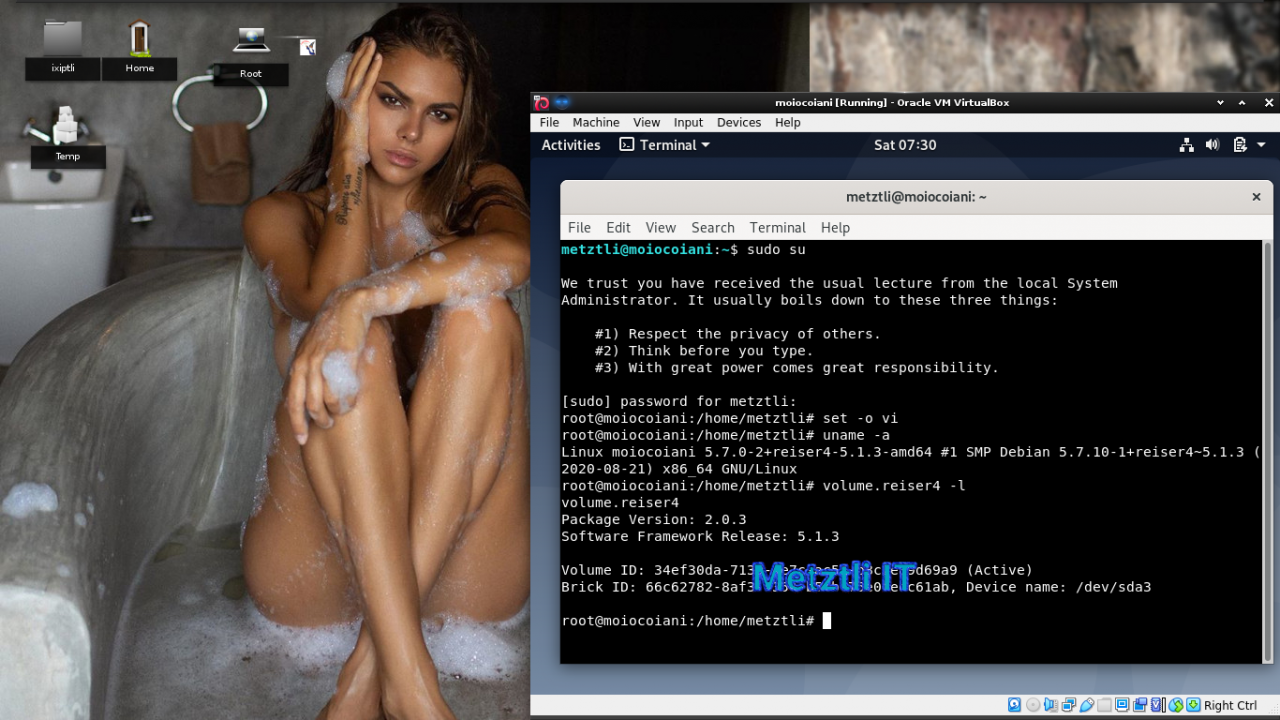
After adjusting the video driver resolution in the VirtualBox 6.1.12 hypervisor 2 virtual machine with moiocoiani hostname:
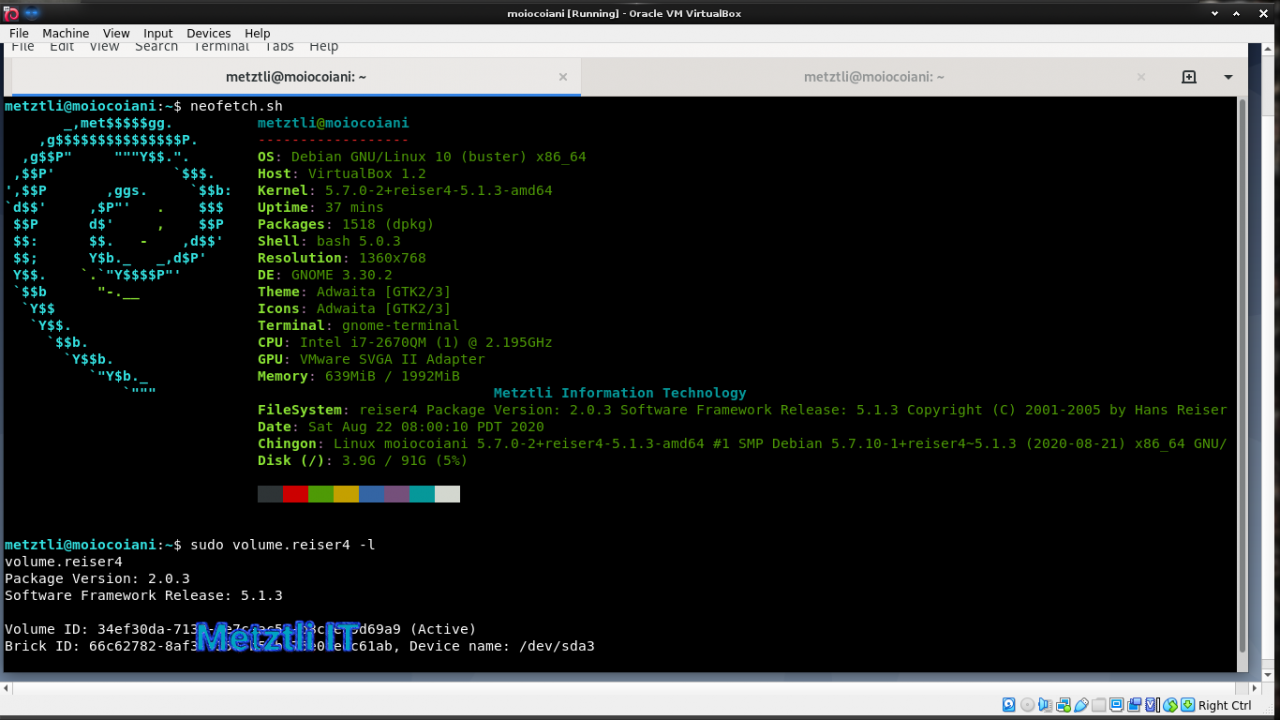
References: Виктория Одинцова : Viktoriya Odintcovo ~ Viki- Xochiquetzal's Instagram
DISCLAIMER![]() although due diligence has been applied, this resource is made available for testing/evaluation purposes on an AS IS basis. The procedure only reflects my own modifications, my limited testing, and the potential user(s) who execute(s) the procedures assumes all risks.
although due diligence has been applied, this resource is made available for testing/evaluation purposes on an AS IS basis. The procedure only reflects my own modifications, my limited testing, and the potential user(s) who execute(s) the procedures assumes all risks.
Please do not hold me or Metztli Information Technology (and/or its associates) responsible if the information provided here does not achieve the desired result. The information is provided AS IS and with the hope that it may be useful to the Internet community --especially those open-minded individuals interested in Reiser4 continued development.
Notwithstanding, There is no implicit or explicit guarantee that the information presented here is accurate --even though due diligence was exercised during the procedure. Accordingly, if an user(s) decide to download resources, implement the procedure or shell commands described here she, he, or them, do so at her, his, or their own risk. You have been forewarned.
Metztli IT, but not other entities, reserves the right to modify the content -- to correct and/or elucidated procedure(s), for instance -- and/or even delete all or partial, including blog post, without previous notice.

